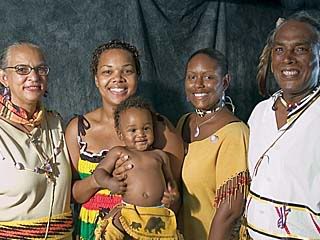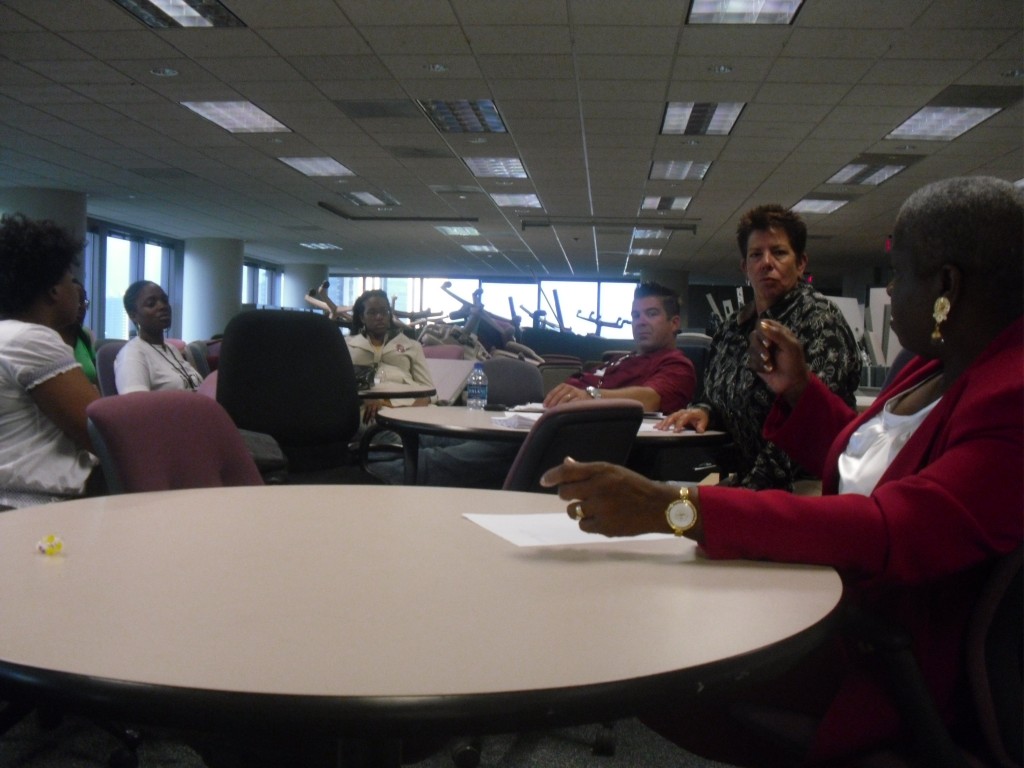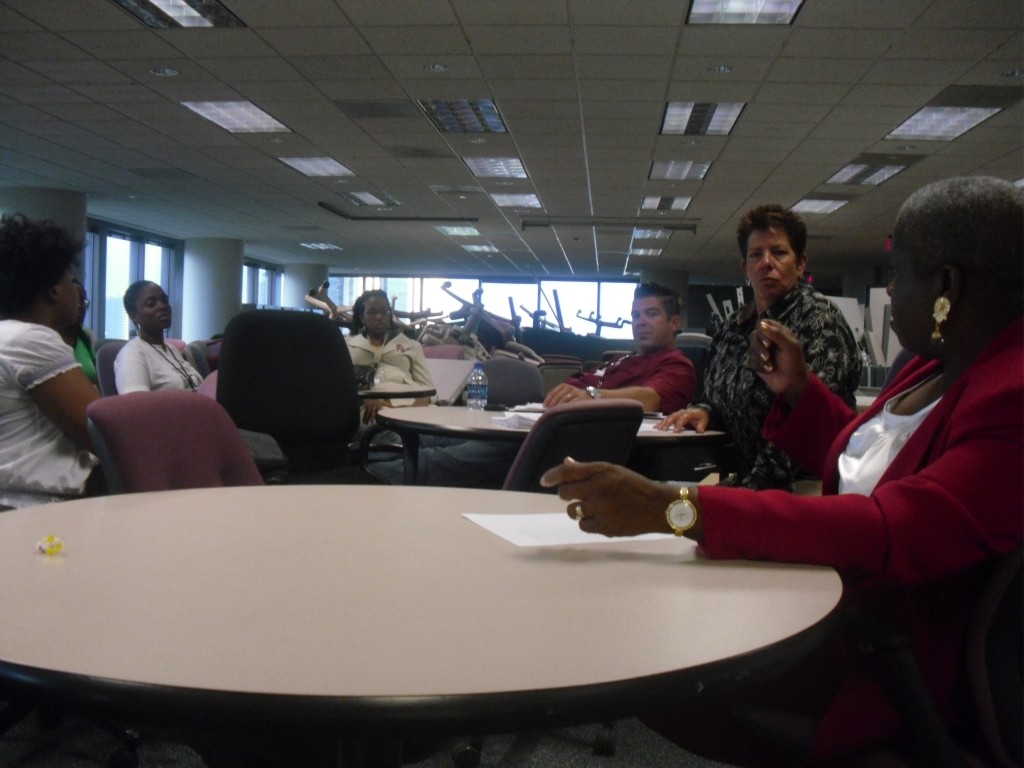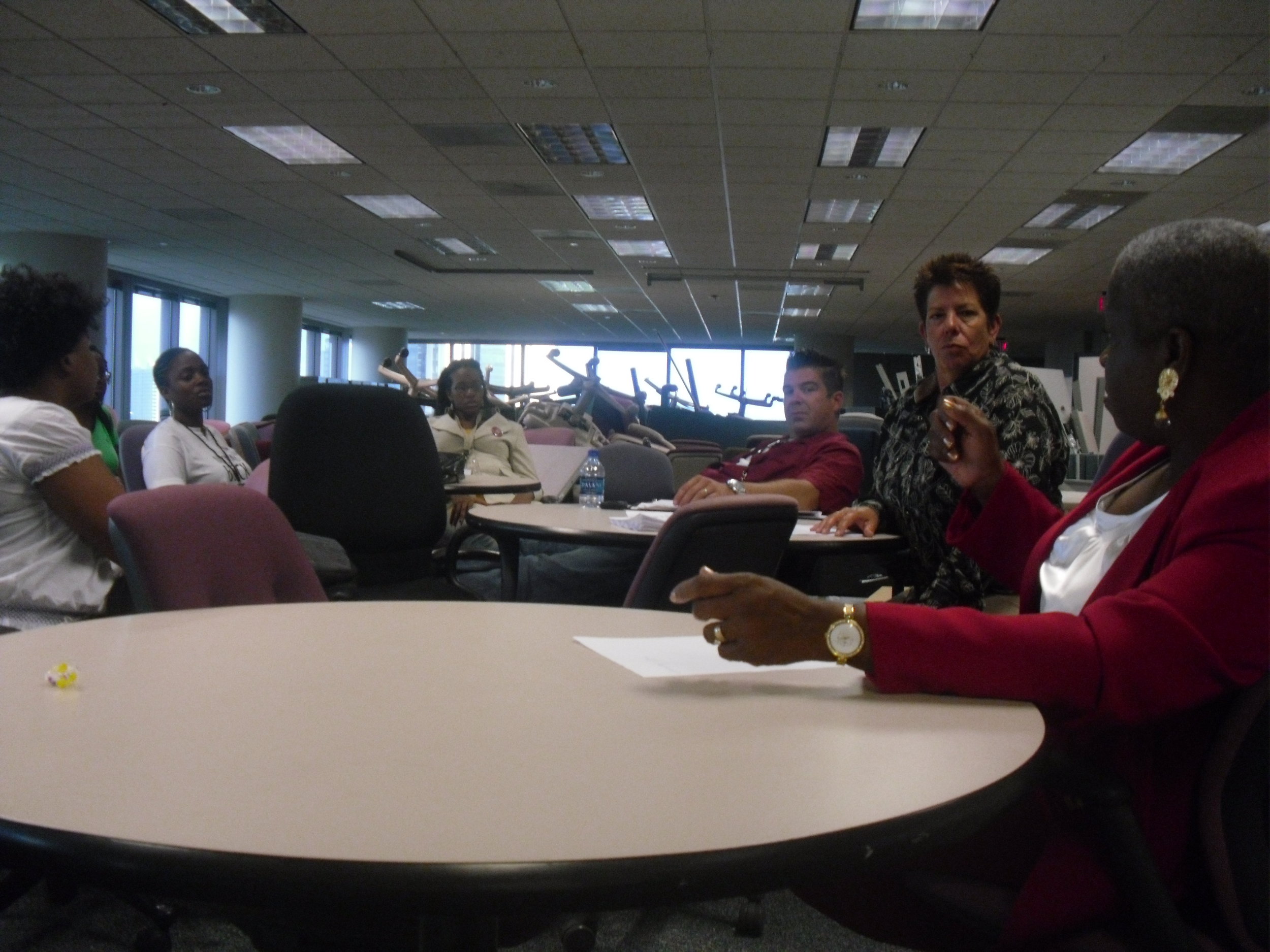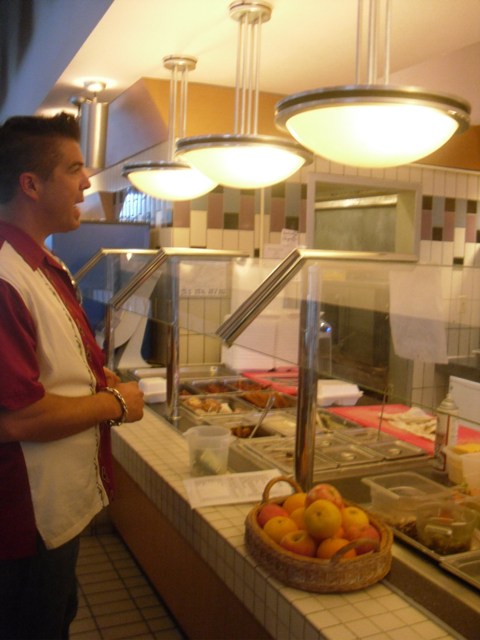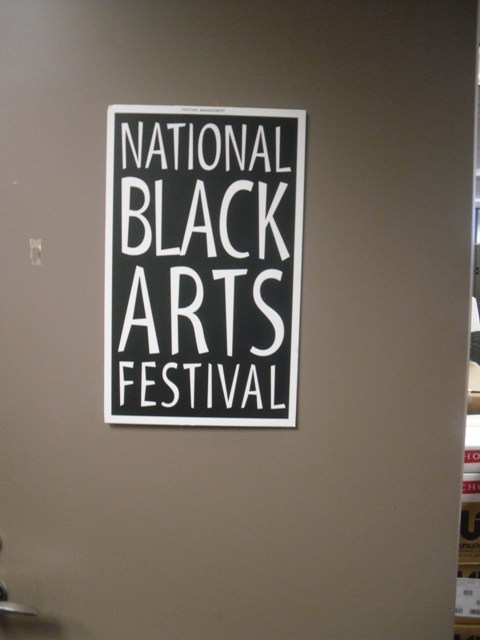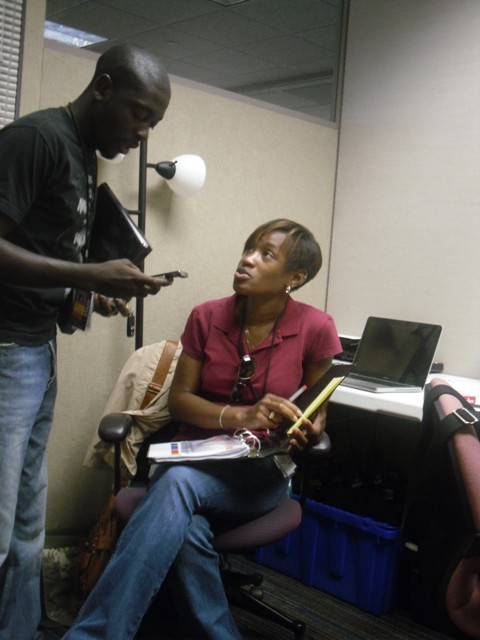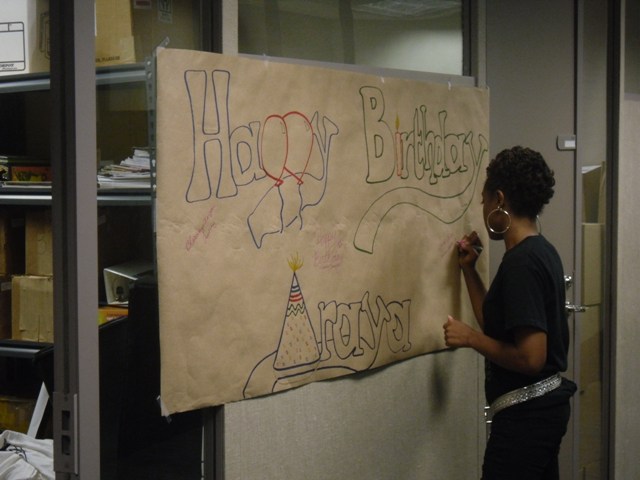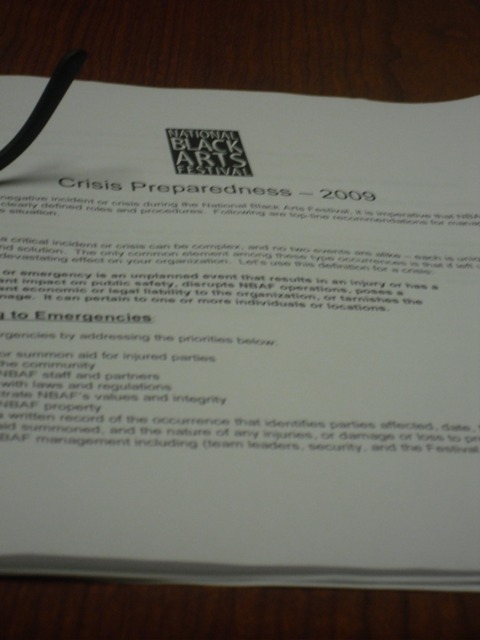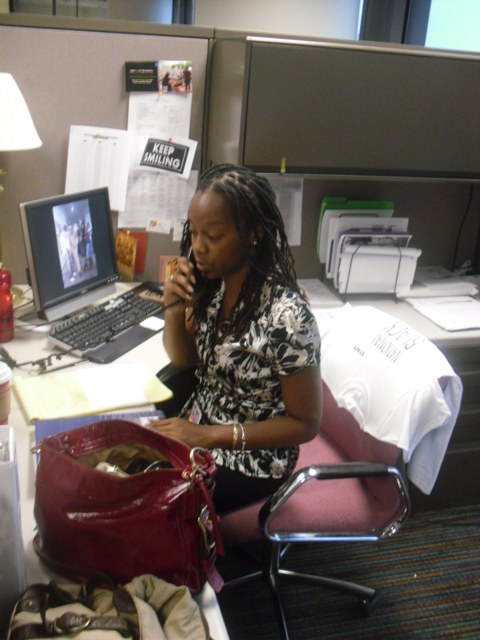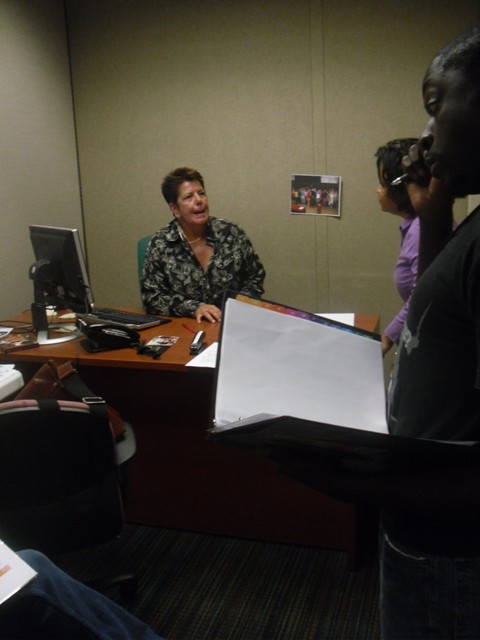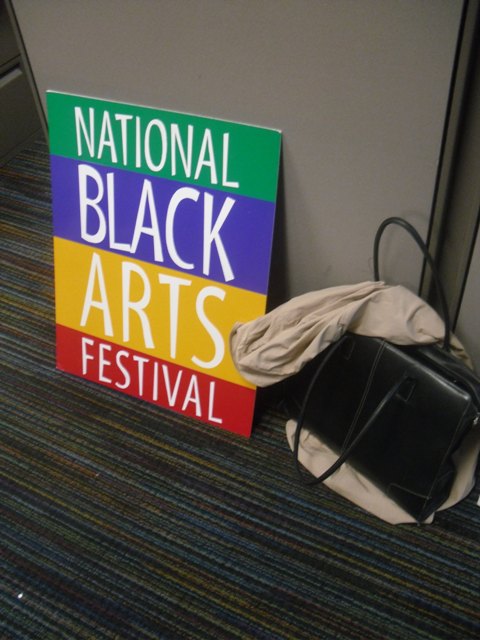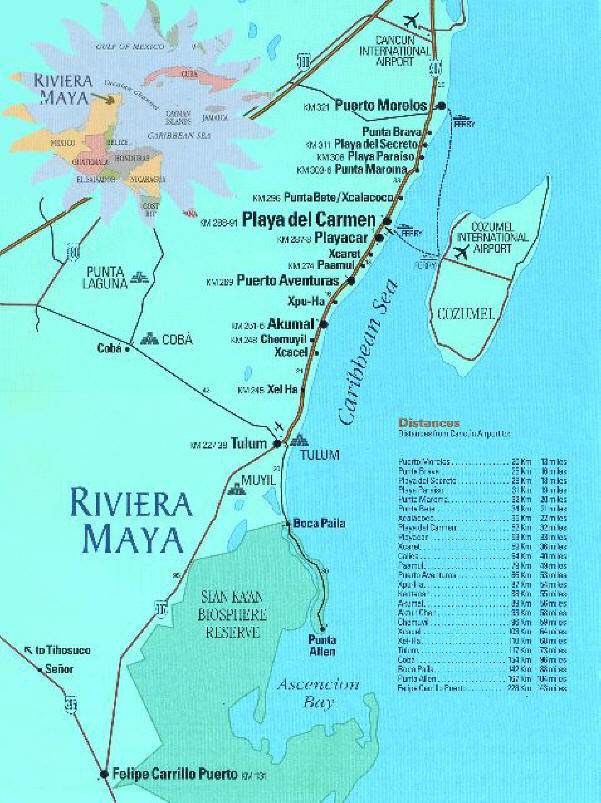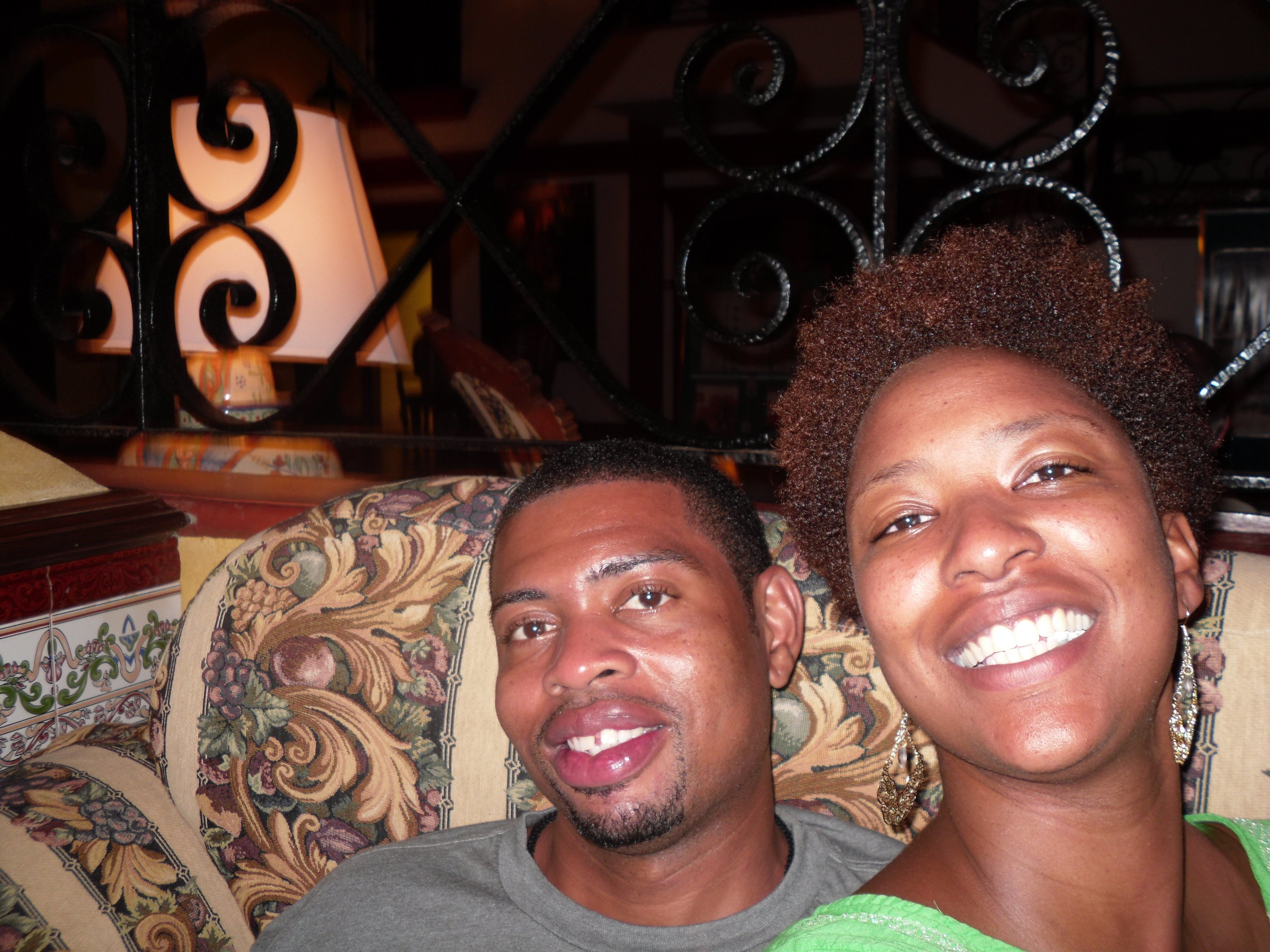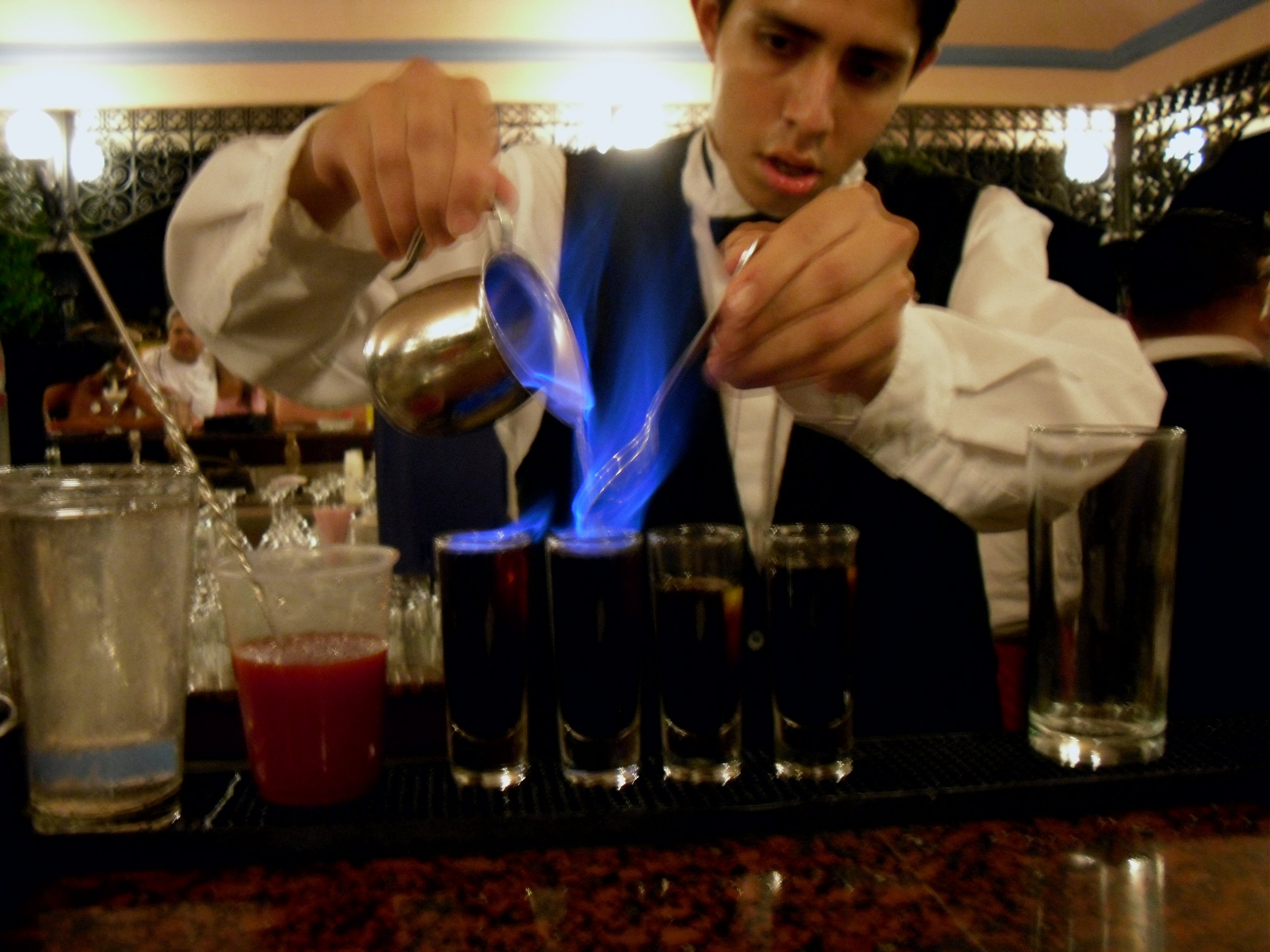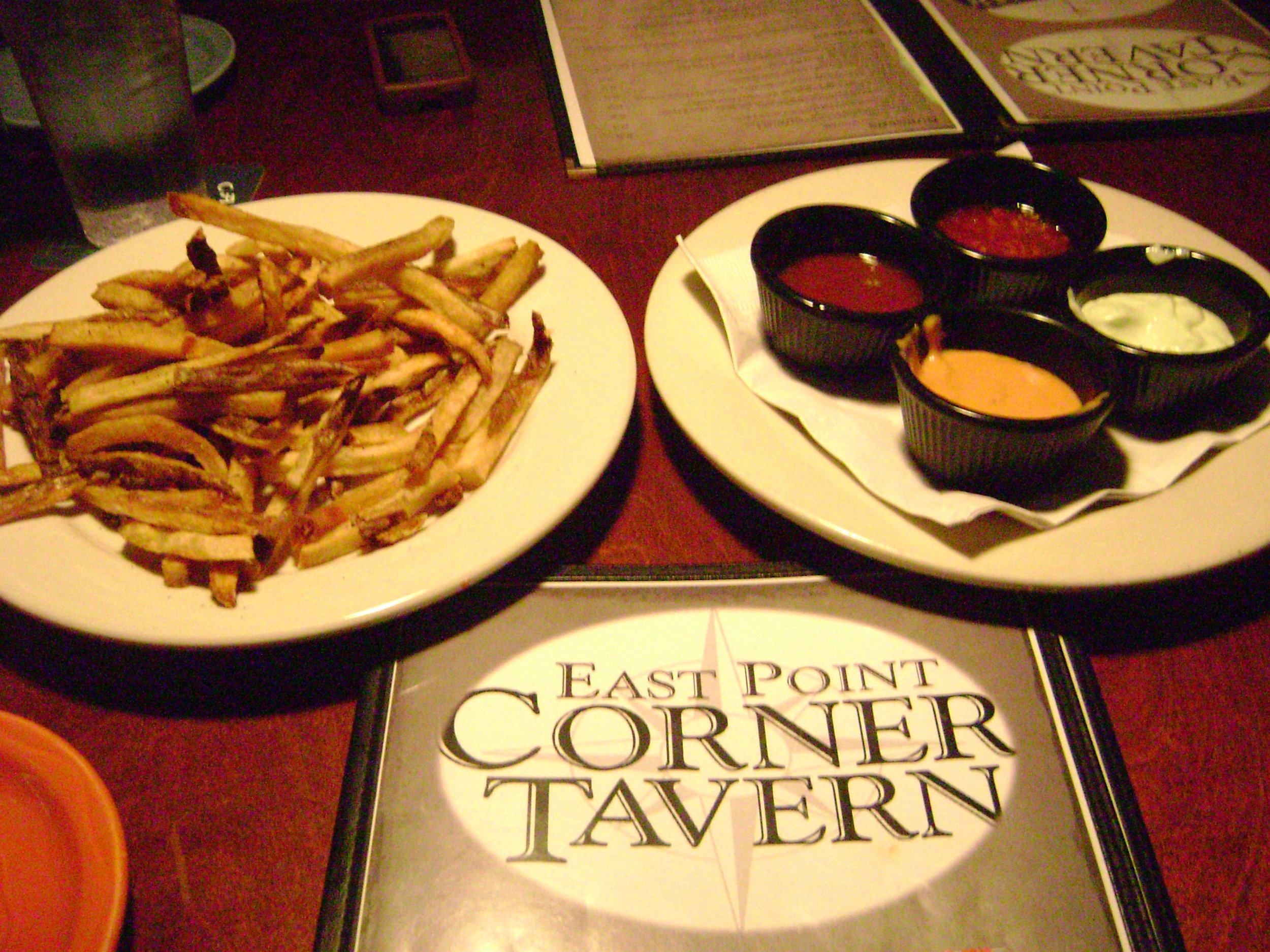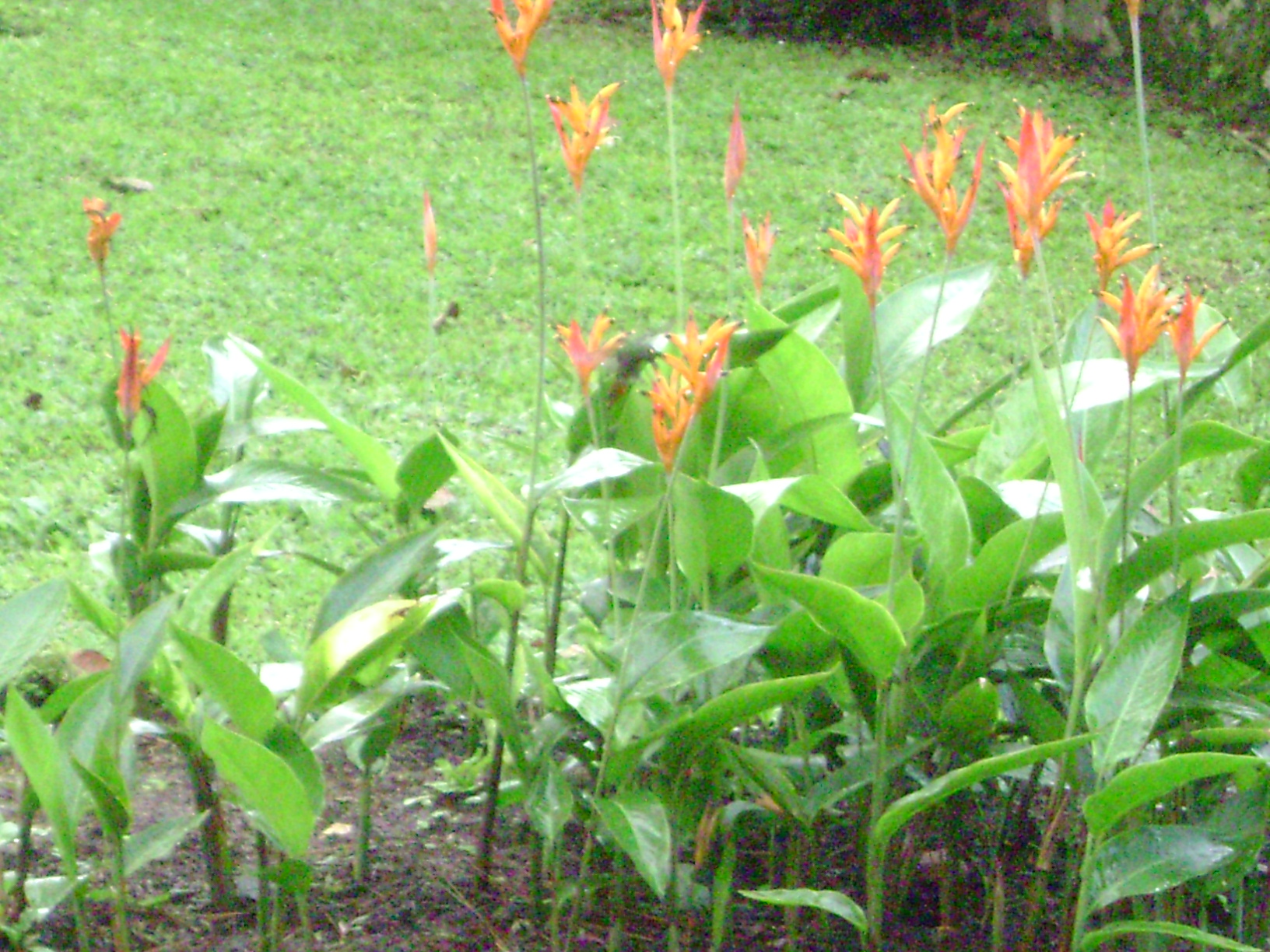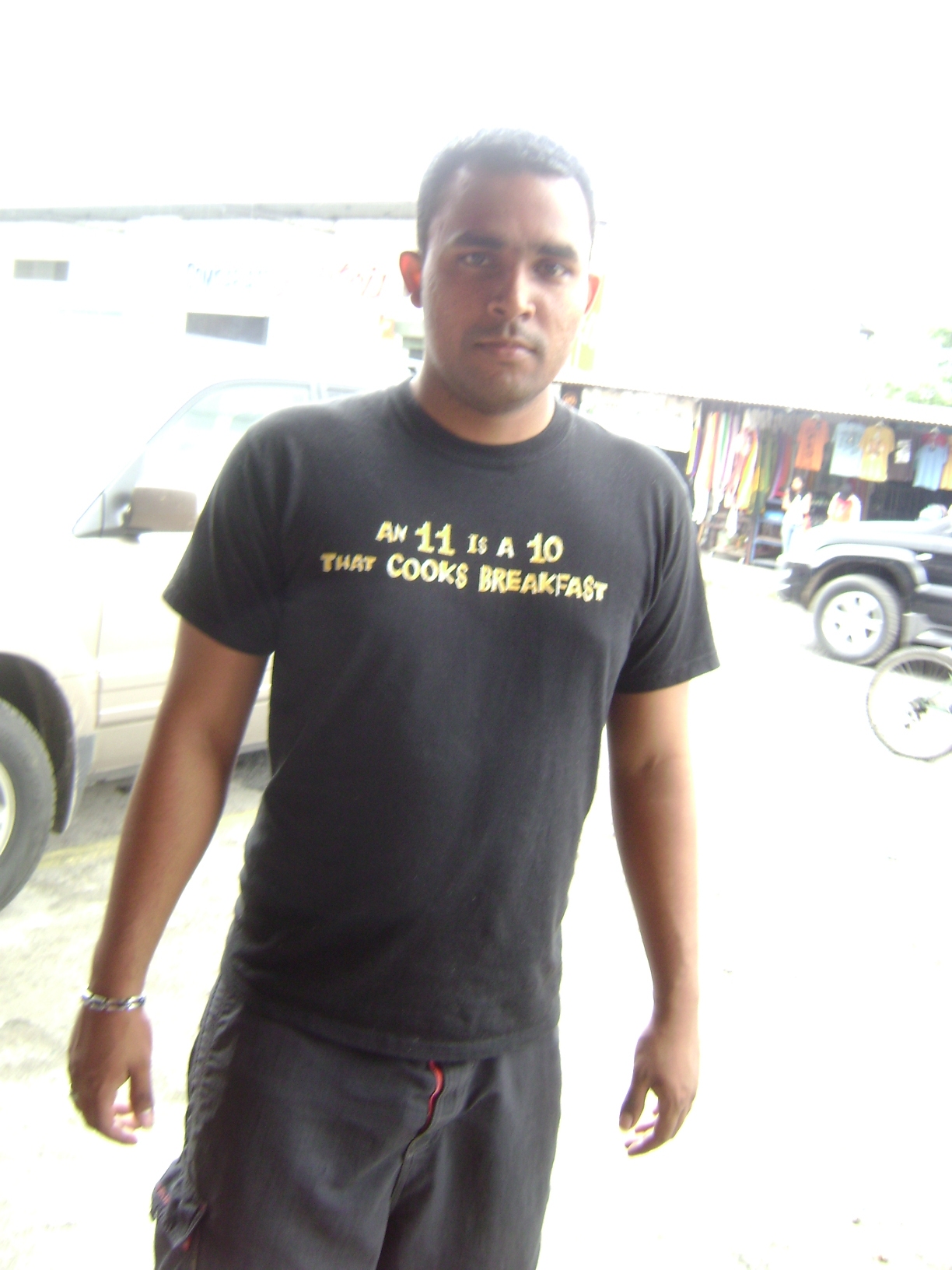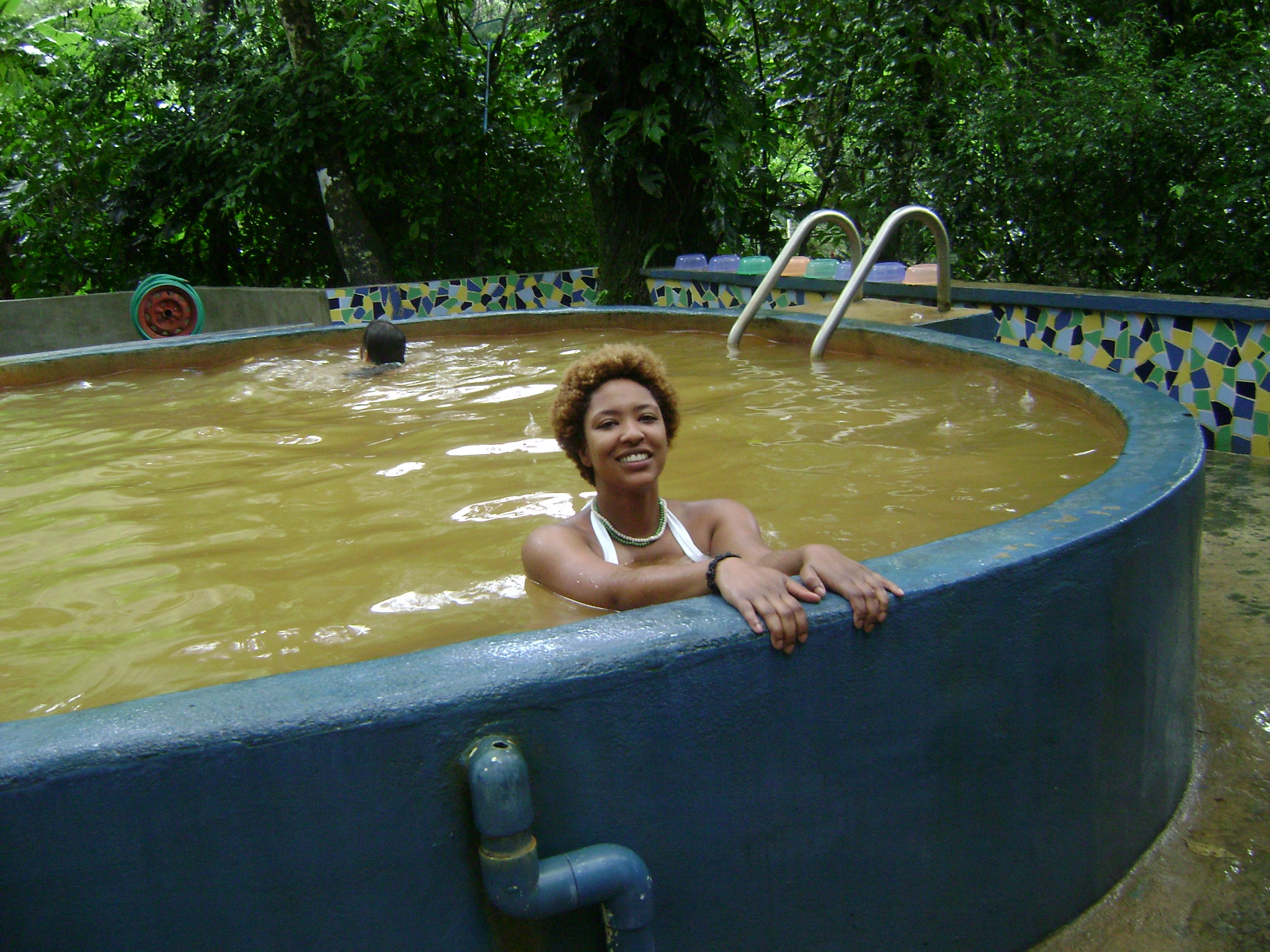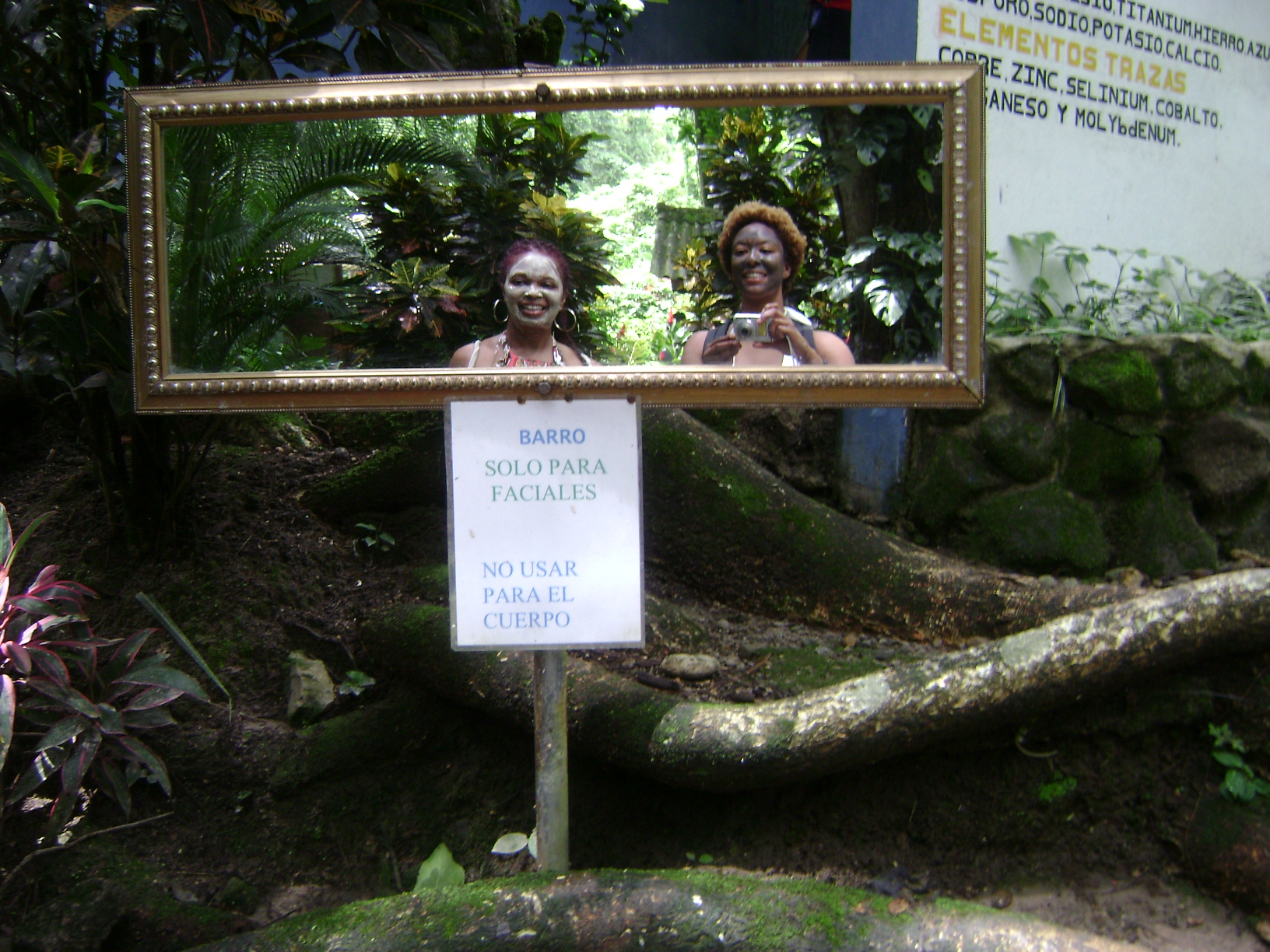how to live happily ever after
The secret to living happily ever after. Simple tips to take you from 'either/or' to 'all of the above'.
I saw a funny-but-true statement on the internet the other day. It went:
Question: What’s the difference between a Northern fairy tale and a Southern fairy tale?
A Northern fairy tale begins with, “Once upon a time…”.
A Southern fairy tale begins with “Y’all ain’t gonna believe this sh*t!”
Well, y’all ain’t gonna believe this sh*t, but… I think I’ve discovered the secret. You know, the big one. The one everyone searches to find from the minute they realize that life is a search to find something.
I’ve discovered the secret to living happily ever after.
Ok, ok. So I didn’t really discover it, I just borrowed it from this guy named Kierkegaard. But hey, if Christopher Columbus can say he discovered America….
Wait a minute, Kisha. Who’s this Kierkegaard guy, and what’s he all about?
Oh. Sorry. I’m getting ahead of myself.
Well, to keep it brief, Soren Kierkegaard was a 19th century Danish philosopher (apparently back in the good ol’ days when philosopher was actually a valid job title). In his book ‘Either / Or’, he explains this idea that one has to progress through 3 stages on the way to becoming one’s true self (aka, living happily ever after).
Here’s my summary:
Aesthetics (Love of Pleasure) – The First Stage
In this stage, one is concerned with maximizing pleasurable sensory experiences. Music, food, drinking, sex, travel, art, poetry, pleasurable memories, and the like. Even the anticipation of pleasure is maximized by someone in this stage. The primary purpose of this pleasure-seeking is to combat boredom. But since pleasure is usually temporary, the person at this stage is constantly pursuing the next pleasure to battle the boredom that always returns.
Ethics (Love of Others) – The Second Stage
At this stage, one is concerned with how his actions affect others. Instead of being driven by self-pleasure or personal gain, the ethical person is driven by pleasing others, adhering to a certain set of social principles, and doing things for the good of society as a whole. The ethical person is in a constant battle with anxiety – the anxiety of not being good enough, or not being accepted by society.
Religion (Love of God) - The Third Stage
In this stage – which Kierkegaard considered the highest plane – one is concerned with her personal, spiritual quest, or her personal relationship with God above all else. Unfortunately, very few reach this stage because of the distraction of large-scale religion which discourages personal relationship with God, and encourages being ‘falsely religious’ by adhering to one-size-fits-all doctrines. The person at this stage battles the despair of trying to live an authentic, spiritual life in a religious world.
Kierkegaard proposed an either / or approach – that is, you either dedicate your life to love of pleasure, love of others, or love of God. But instead of either / or, why not ‘all of the above’?
You see, living happily ever after means you get to have it all. You don’t have to choose between one way of living or another. It’s your fairy tale. You own everything!
In my opinion, to live happily ever after you have to find a way to balance all 3 of these loves. Thinking and living in terms of ‘either/or’ will almost certainly lead to a life of excess or imbalance. With the either / or mentality, something will always be lacking, missing, or given up. So, how can you start to move from 'either/or' to 'all of the above'?
The Path to Happily Ever After
Appreciate More – Or, exercise your 'pleasure muscle'. Instead of pursuing or chasing pleasure, derive pleasure from more and more things – even the simplest things. This will likely require a shift in perception, maybe even a slowing down. Instead of rushing through traffic or hurriedly gobbling down a meal, or speeding through your household chores, take time to savor something about every moment you experience. The more you do this, the more you’ll realize that pleasure isn’t something that has to be chased down, it’s something that has to be tuned into.
Give More – Now, I want to be clear here. I’m not necessarily suggesting that you sign up for another committee to save the world or keep going out of your way to be all helpful and savior-ish to everyone you know. On the contrary, I think many people (especially women, since we are often trained to be over-givers) should be more conservative with how much of themselves they’re giving away and who they’re giving it to. What I’m talking about here is giving more of the things that you have – whether they be material things or abstract things. Give more compliments, give away more credit (even if you did the work), give away more ideas, give away more of your belongings. Remember, you own everything, so why should you be so concerned with clinging so tightly to it all?
Meditate More - It takes a tremendous amount of energy to just sit still and shut the hell up. To calm your brain, cancel-out all the inputs and just be in silence (not even in deep thought). If you’ve ever tried meditating, you probably know that even seemingly harmless, little itty-bitty thoughts can quickly balloon into monstrous distractions.
By meditating more, you develop the discipline and strength you need to find God or your spiritual center even in the midst of all the distractions that life presents. Imagine More – Or, exercise your 'faith muscle'. Imagining is a way of reminding yourself that everything is possible. Even the seemingly absurd. Many of us SAY that God is the source from which all good things flow or that the universe is abundant and overflowing. But the way we ACT is that God or the universe is judgmental, demanding, and always ready to punish. The reality is YOU’re the one doing the punishing, the demanding, and the judging by believing you’re not worthy of good things, or by not having faith in the idea that almost anything you think of, can happen in real life. Think of it this way, whenever you present something to God (or the universe, or whatever you choose to call it) the answer is always yes. If you continually present ideas that affirm negative thoughts about you and the world around you, the answer will be, “yes”. Whatever you focus your mind on has a way of materializing. So instead of using your mind to focus on the negative, dedicate time to imagining the best possible things you can, and watch for the “yeses” to roll in.
cheers, k
how to cook with mushroooms - 3 recipes
Plant? Mineral? Animal? You might not know exactly what category to put mushrooms in, but you can file these 3 meatless, mushroom-based dishes under quick, healthy, or delicious.
 I find that the mushroom is one of those food items that people either love or hate. Admittedly, mushrooms are a bit… creepy. I mean, after all, a mushroom is technically neither plant, nor mineral, nor vegetable, but a (gulp) fungus. And even though I fall in the ‘love ‘em’ camp, I can’t deny occasionally feeling just a bit weirded out – yet still strangely fascinated – by them. If you fall in the hate ‘em camp, I doubt I can do anything to convince you otherwise, but if you’re teetering somewhere on the edge of either camp, maybe these mushroom facts will sway you.
I find that the mushroom is one of those food items that people either love or hate. Admittedly, mushrooms are a bit… creepy. I mean, after all, a mushroom is technically neither plant, nor mineral, nor vegetable, but a (gulp) fungus. And even though I fall in the ‘love ‘em’ camp, I can’t deny occasionally feeling just a bit weirded out – yet still strangely fascinated – by them. If you fall in the hate ‘em camp, I doubt I can do anything to convince you otherwise, but if you’re teetering somewhere on the edge of either camp, maybe these mushroom facts will sway you.
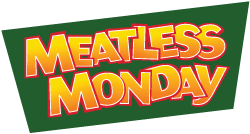 For the past few months, we’ve been doing Meatless Mondays at my house, and mushrooms have often played a starring role in dishes where we’d normally feature meat. The benefits of using mushrooms as a meat replacement are seemingly endless: they’re cheaper, cook faster, have no cholesterol, very little fat and sodium, and are chock-full of essential nutrients like potassium, selenium, and B vitamins. All of which makes the mushroom quite magical in my eyes.
For the past few months, we’ve been doing Meatless Mondays at my house, and mushrooms have often played a starring role in dishes where we’d normally feature meat. The benefits of using mushrooms as a meat replacement are seemingly endless: they’re cheaper, cook faster, have no cholesterol, very little fat and sodium, and are chock-full of essential nutrients like potassium, selenium, and B vitamins. All of which makes the mushroom quite magical in my eyes.
Here are some of my favorite mushroom recipes:
Mushroom Quinoa Risotto (from Bon Appetit)
In this recipe, portabella and shiitake mushrooms are paired with so-called superfood quinoa (keen-wah) to create a much lighter, healthier version of a traditional risotto. It still has the rich-tasting, heartiness of risotto without the guilt or the lengthy, labor-intensive preparation, which makes it an ideal candidate for a weeknight dinner. You must try this.
Fried Parmesan ‘Shrooms over Tomato Sauce
(inspired by Lunacy Black Market)
One of the dishes I always order from my favorite Atlanta restaurant is roasted mushrooms w/crushed tomato sauce. The savory, umami flavor of the ‘shrooms and the tangy tomato sauce are enough to make my mouth water at the mere mention of the dish. When doing my own home-based version of the dish, I alternate between roasting the ‘shrooms or frying them as detailed below. This is a regular go-to dish for weekday dinners when I want to be in and out of the kitchen in less than 30 minutes.
Ingredients (serves 2-3):
4-5 roma tomatoes, chopped (you could also sub ~20 grape tomatoes)
1-2 cloves of garlic, chopped
1 shallot or small onion, chopped (optional)
Dried basil
Portabella mushrooms, washed, de-gilled and sliced into thick 1”slices (you can also buy them pre-sliced to save time)
1-2 eggs
Bread crumbs
Olive or canola oil
Grated parmesan cheese
For tomato sauce: Add a swirl of olive oil to a pot. Heat on medium-high. Add chopped garlic and shallots and sauté for 3-4 minutes, being careful not to brown garlic. Add basil and sauté for another minute. Add tomatoes. Cover pot with a lid, lower heat to medium or medium-low and let the mixture simmer rapidly for about 15-20 minutes, or until tomatoes start to break down. Stir occasionally and mash tomatoes so that they meld with the other ingredients. You want to end up with a chunky sauce. Salt and pepper to taste, then remove from heat.
For mushrooms: Beat egg well in a bowl and place mushrooms in bowl. Toss mushrooms well to coat with egg. Place bread crumbs in a small paper or plastic bag. Add egg-coated mushrooms to bag and shake well to coat with breadcrumbs. Add enough oil to pan to cover bottom of – about 2-3 Tbsp – or if you prefer, you can use more oil to deep-fry mushrooms. Heat oil on medium-high. When oil is hot, add mushrooms one at a time, making sure not to overcrowd the pan. Cook until mushrooms are golden brown on one side, then flip and cook until golden brown on the other side. Remove and drain on paper towel. Sprinkle immediately with grated parmesan. Place a few spoonfuls of tomato sauce on a plate and place a few mushrooms on top of sauce. The mushrooms are also really good over a salad of dressed mixed greens, or eaten by themselves.
Mushroom, Goat Cheese, and Arugula Flatbread Pizza
(inspired by Wrecking Bar Brewpub)
Everybody loves pizza. Unfortunately, pizza doesn’t love everybody. Your typical pie is nothing more than a cheese  delivery system, and is usually topped with fatty meats and salt-laden sauces, and bottomed with a waistline-wrecking white-flour crust. But it doesn’t have to be that way, I promise. The Wrecking Bar, a delightful little gastropub in Little Five Points, serves a version that features 3 types of mushrooms and a healthy smattering of peppery arugula. Here’s how I replicate the dish at home (or in my office toaster oven).
delivery system, and is usually topped with fatty meats and salt-laden sauces, and bottomed with a waistline-wrecking white-flour crust. But it doesn’t have to be that way, I promise. The Wrecking Bar, a delightful little gastropub in Little Five Points, serves a version that features 3 types of mushrooms and a healthy smattering of peppery arugula. Here’s how I replicate the dish at home (or in my office toaster oven).
Ingredients (serves 2-3):
Lavash or other flatbread (preferably whole-wheat)
Goat cheese (a soft, spreadable one)
3-4 of each of the following mushrooms, chopped: oyster, shiitake, portabella or baby portabella
Handful of fresh arugula
Olive oil
Spread goat cheese onto flatbread. Evenly distribute chopped mushrooms over goat cheese, then add arugula on top. Drizzle with olive oil. Place in 400 degree oven for about 5 minutes, until arugula is wilted. Salt and pepper to taste. You could add more flavor by adding roasted garlic, pesto sauce, sundried tomatoes, or fresh herbs (basil, sage, thyme) before the pizza goes into the oven.
I hope these recipes encourage you to experiment with mushrooms. If you’re the really adventurous types – I recommend trying some of the more exotic varieties like porcini, shiitake, oyster, hen of the woods and enoki. The taste of those varieties is much richer and more complex than the more common white button or portabella mushrooms. And if you choose to experiment with magical mushrooms outside of the kitchen, well… that’s totally up to you. ;)
cheers,
k
my essential kitchen tools
essential tools of the craft for today's kitchen witches and wizards.

A practitioner is only as good as the tools he uses to produce his work. Since I fancy myself a kitchen witch, I thought I'd share some of my favorite tools of the craft that help make cooking easier, faster, and more enjoyable.
My Essential Kitchen Tools
- Non-stick cookware w/matching lids - Non-stick cookware makes cleanup easy, and because of that, my set of non-stick pots and pans are my everyday go-to cooking tools. While it isn't necessary to have a full set (you might even come out better with mix-and-match pieces), it is advised to spend a little extra for quality non-stick cookware that won't chip and peel as soon as you start using them. For the basics, I recommend a large pot (suitable for pasta and soups), a medium-sized saucepan and a large skillet.
- Rubber spatula - A must-have for cooking on non-stick cookware so you don't damage the non-stick coating.
- Stainless steel skillet or saucepan - To make a quality sauce, you have to get some caramelization on the bottom of the pan. Same goes for searing meats. This simply cannot be achieved with non-stick cookware. A single 12-inch saute or fry pan should be enough for most kitchens.
- Metal spatula - A must-have for scraping the caramelized bits (or fond) from the bottom of stainless steel pans. Never, ever use it on non-stick cookware.
- Baking sheet - I prefer metal baking sheets which help caramelize roasted vegetables and meats. For easier cleanup or non-stick baking, I line the sheet with foil or parchment paper. If you only have one, I'd recommend one with a lip or raised edge to keep food or juices from sliding off into the oven.
- Rectangular baking dish - Perfect for casseroles and cobblers.

- Tongs - Like having a heatproof pair of hands. Ideal for handling items in hot oil or water and for turning meats without piercing the skin and letting precious juices escape.
- Peeler - Why torture yourself trying to peel fruits and vegetables by hand? A peeler makes quick work of the task.
- Mandolin - While this isn't an everyday tool, it comes in handy when I need thin, evenly-sliced veggies for salads. Works like a charm when making homemade potato chips.
- Mini chopper - While I do own a large food processor, I rarely use it because it's so big and I'm not usually chopping huge amounts of food at once. My 4-cup mini-chopper is more practical for finely chopping fresh herbs and veggies when making sauces, salad dressings, salsas, soups and stews.
- Chinese skimmer - This handy tool is great for removing fried items from oil and for removing pastas (like ravioli, farfalle, etc.) or vegetables from boiling water.
- Latex gloves - I keep a supply on hand for messy manually-intensive tasks like forming meatballs, and for dealing with raw meats and poultry. Be sure to use the non-powdered variety.
 Mortar and pestle - Some folks swear by their spice grinder. For me, a good stone mortar and pestle are all I need to grind up a small amount of dried herbs or spices.
Mortar and pestle - Some folks swear by their spice grinder. For me, a good stone mortar and pestle are all I need to grind up a small amount of dried herbs or spices.- Wok - Honestly, if I could only have one piece of cookware, it would be a wok. It's versatile enough to use for boiling, stewing, frying, steaming, and even for popping corn. I have 3 in my cabinet, but prefer the hand-hammered steel one to the 2 non-stick ones.
- 2-3 good knives - Nothing makes prep more enjoyable than a good quality, sharp knife. There's no need to get that variety set that comes in the wooden knife block, since you won't use half of them. An 8-inch chef's knife and 1-2 smaller knives (a 6-inch and/or a paring knife) are more than adequate for most kitchen tasks. Henckel's or Wusthoff are recommended brands. The quality is well worth the price. You'll have these forever.
- 2 cutting boards - I recommend at least 2 cutting boards - 1 for raw meats and 1 for veggies and other cutting tasks. Wood or plastic is up to you, but glass cutting boards can dull your knives faster.
- Knife sharpener - Your knives will get dull over time. To save the hassle of having someone else sharpen them and to protect your investment, get yourself a simple sharpener.
- Utility scissors - Couldn't spatchcock a chicken without 'em! They also come in handy for clipping fresh herbs.
- Whisk - How else are you going to whip cream or make stiff peaks out of egg whites? A standard wire balloon whisk should be sufficient.
- Stick / hand blender - I mostly use mine for making smoothies, but it's a godsend when I need to puree a soup.
- Wire colander/strainer - A must-have for draining pasta, beans and other items. Can also do double-duty as a sifter.
- Measuring cups / spoons - I hardly follow exact measurements when cooking my own recipes. But when
 following someone else's or on the rare occasions when I bake, measuring cups/spoons are absolutely necessary.
following someone else's or on the rare occasions when I bake, measuring cups/spoons are absolutely necessary. - Parchment paper - As I mentioned before, I don't bake often, but baking cookies and brownies on parchment reduces the risk of burnt-bottom (I mean, unless you're into that) and makes cleanup much, much easier.
- Aluminum foil - See #5 and #23.
- Set of kitchen towels - When cooking, my hands are constantly getting dirty and constantly getting rinsed or washed between steps in the cooking process. One of the first things I do before cooking is make sure I've got at least one towel on hand. Most times I tuck it into my back pocket or toss it over my shoulder, so I have easy access to wipe or dry my hands or whip it out for more heavy-duty uses. In a pinch, I also use my kitchen towel to handle hot pans or lids.
photo 1: Auxillary home kitchen tools. by Special*Dark, on Flickr photo 2: Baking Dish 2/14/11 by esimpraim, on Flickr photo 3: mortar & pestle by ani!, on Flickr photo 4: my fancy new measuring cups by knittygurl, on Flickr
inappropriate dinner conversation: the curious case of the Cherokee Freedmen
The year is 1983. 6 men arrive at a voting precinct in Oklahoma. The men are of varying ages and statures, but there is at least one trait that they all share. They are all black. As they approach the door of the precinct, their leader, a Reverend called Nero, issues a quick word of encouragement to his band of braves. The men steady their nerves and their resolves. Not one of them is sure what may happen next.
It only takes a few moments for it to all be over. The men return to their vehicles, not a single vote cast among them. They have been turned away from the polls this day for the simple fact that only citizens of this nation are allowed to vote. And, because they are black, these men are not considered citizens.
Though the details in the story above were imagined, the story itself is very much based on actual events that happened in these United States in the far, far away state of Oklahoma in the long ago time of 1983.
The men in the story are descendants of a little-known group of people referred to as the Black Freedmen. Once owned as slaves by wealthy and usually mixed-race Cherokees, the Black Freedmen were emancipated and granted full citizenship in the Cherokee Nation in an 1866 treaty between the Cherokees and the US government. Since then, the Black Freedmen’s story of equal acceptance into the Cherokee Nation has been a twisted one fraught with legal entanglements, questions of culture and identity, and sturdy allegations of fraud and good ol’ American racism.
as slaves by wealthy and usually mixed-race Cherokees, the Black Freedmen were emancipated and granted full citizenship in the Cherokee Nation in an 1866 treaty between the Cherokees and the US government. Since then, the Black Freedmen’s story of equal acceptance into the Cherokee Nation has been a twisted one fraught with legal entanglements, questions of culture and identity, and sturdy allegations of fraud and good ol’ American racism.
I’d really never heard of the Black Freedmen until a Facebook friend of mine shared an article from MSNBC outlining the most recent in a long history of legal battles between the Black Freedmen and the Cherokee Nation. Like many of you might have, I’d heard stories of Blacks and Natives intermarrying and having children together, but I never knew that there was an established and officially recognized group of Blacks that were considered Cherokees – by blood or by naturalization. I’d venture to say it was left out of my required history classes as a young lass.
But after reading the article, it quickly turned from a curious little historical sidenote, into a current-day political conundrum that threatens the concepts of sovereignty and democracy that define our modern government, and brings back into focus basic civil rights issues that, before now, I naively believed had long ago been put to rest in this country.
After a little research, I was able to piece together the following timeline of the Black Freedman’s history from various sources (Gawd, I love the Internets!).
1863 – Cherokee Nation officially abolishes slavery; Some Cherokees who side with the Confederacy continue to hold slaves and fight against the Union in the Civil War
1866 – The Cherokees sign a treaty with post-Civil war US government extending Cherokee citizenship and enfranchisement rights to the freedmen and their descendants. The Cherokee Nation Constitution is amended to reflect the treaty’s language concerning freedmen’s rights.
1880 – The Cherokee Nation conducts a census to assist with the distribution of proceeds from sales of Cherokee land. Cherokee freedmen are excluded from the census and thereby, the distribution of proceeds.
1888 – US government passes An Act to secure to the Cherokee Freedmen and others their proportion of certain proceeds of lands.
1896 – US government commissions the Kern-Clifton roll to identify Cherokee Freedmen that were entitled to Cherokee land sale proceeds. The Kern-Clifton roll identifies 5,600 Cherokee Freedmen.
1902-1906 – The Dawes Commission, enacted by the US government, requires registration of American Indians. The Dawes Rolls classifies individuals as either: Indians by blood, intermarried whites, or Freedmen. Dawes commissioners generally listed all visibly black people as freedmen regardless of Cherokee blood ancestry that would have otherwise qualified some as ‘Indians by blood’. The Dawes roll lists 4,924 Freedmen.
1970s - Under pressure from Indian activists, the Bureau of Indian Affairs (BIA) begins to provide certain benefits, such as free health care, to members of federally recognized tribes. As citizens, Cherokee Freedmen are also eligible for benefits.
1983 - Ross O. Swimmer, then Principal Chief of the Cherokee Nation, issues an executive order requiring Cherokee Nation citizens to have a "Certificate of Degree of Indian Blood" (CDIB) card in order to vote. CDIB cards were issued by the BIA based on those listed on the Dawes Rolls as ‘Indians by blood’. Rev. Robert H. Nero and 5 other Cherokee Freedmen are turned away from polls when they attempt to vote in the 1983 tribal election.
1984 – Rev. Nero and his associates file a class action lawsuit on the basis of racial discrimination against the United States, the Office of the President, the Department of the Interior, the Bureau of Indian Affairs, the tribal election committee, and Principal Chief Ross Swimmer.
1989 – The court rules against Rev. Nero and fellow plaintiffs, citing jurisdictional issues.
2001 - Bernice Riggs, a Freedmen descendant, sues the tribal registrar for citizenship based on blood ancestry. The Judicial Appeals Tribunal (now the Cherokee Nation Supreme Court) rules that Riggs adequately documented her Cherokee blood ancestry, but ultimately denies Riggs citizenship because her ancestors were listed only as Freedmen on the Dawes Rolls, not as ‘Indians by blood’.
2006 - The Cherokee Nation Supreme Court rules in favor of Freedman descendant Lucy Allen. The ruling concludes that acts barring Freedmen descendants from tribal membership are unconstitutional , since the 1975 Cherokee Constitution did not exclude Freedmen from citizenship, nor did it have a blood requirement for membership in the tribe.
And this is where the real fun begins.
After generations of being bounced back and forth between Cherokee and non-Cherokee statuses, the Black Freedmen finally regained their constitutional rights as Cherokee citizens in 2006. But before the Freedman could even get out a rousing refrain of ‘We Shall Overcome’, what happened?
The Cherokees changed the Constitution.
Damn.
In a series of political moves with dubious ethical connotations, high-ranking Cherokee leaders swiftly drafted a petition for a special election that would allow the Cherokee Constitution to be amended to exclude Black Freedmen as citizens. Despite accusations by some tribal leaders that signatures on the petition were forged, the required signatures were obtained, and in 2007, the Cherokee Nation voted to expel the Freedmen from the nation.
Double damn.
Advocates of expelling the Freedmen openly used racist rhetoric to rally voter support. In tribal leader Darren Buzzard’s 2007 email, he urged Cherokees, “Don’t let black freedmen back you into a corner. PROTECT CHEROKEE CULTURE FOR OUR CHILDREN. FOR OUR DAUGHTER[S] . . . FIGHT AGAINST THE INFILTRATION."
Buzzard and others on his side of this issue contend that such inflammatory language is a matter of tribal pride, not racism. But proponents of the Freedmen cause, like professional genealogist and author Angela Walton-Raji, declared, “It is the blackness of the Freedmen descendants that is despised, NOT the love of those with Cherokee blood.”

And boy is that Cherokee blood valuable. Even Buzzard knows that. In his email, he also cautioned his Cherokee tribesmen, saying, “They will suck you dry.” The ‘they’ Buzzard referred to were the Freedmen. But suck them dry of what, exactly?
Maybe Buzzard was referring to the Cherokee Nation’s share in the 20-plus-billion-dollar-a-year American Indian gaming industry. Or maybe he was talking about the estimated $300 million of funds that the Cherokee Nation receives annually from the federal government. That’s right. Every year. $300 million. From your democracy-loving, tax-paying pockets.
Luckily, some folks at the Congressional Black Caucus pulled the Cherokee Nation’s card on trying to have its cake and eat it too. In 2007, Rep. Diane Watson of California and several other Black Caucus members introduced a bill that sought to sever the Cherokee Nation’s federal recognition, strip the Cherokee Nation of their $300 million-a-year federal bankroll, and stop the Cherokee Nation’s gaming operations if the tribe failed to honor the Treaty of 1866.
In other words, Diane counted coup on that ass.
The Cherokees’ reply to the bill was essentially, ‘Why are you picking on us, when everyone else is doing it too?’ The official response from then Chief Chad Smith claimed that the bill was “in retaliation for this fundamental principle that is shared by more than 500 other Indian tribes.” In a compromise between Congressional Black Caucus members and their American Indian counterparts, the bill was later modified to allow the Cherokee Nation to continue receiving federal funding as long as some settlement is reached in lawsuits concerning the Freedmen’s citizenship.
As of the writing of this post, at least one of those lawsuits is still pending, and will be heard in a Washington, D.C. court beginning Tuesday, September 20. Attorneys are asking a judge to restore voting rights for the ousted Cherokee Freedmen in time for the September 24 tribal election for Principal Chief. That lawsuit will mark another – and possibly the final – chapter in the Black Freedman of the Cherokee Nation’s fight for citizenship.
Yet even now, the brazenly exclusionary and racist dialogue regarding ‘outsider Indians’ continues. In a post dated June 14, 2011 on the Native American news and entertainment site Indianz.com, Wambli Sina Win, an individual who has held positions in both Native and U.S. legal systems, including Tribal Judge for the Oglala Sioux Tribal Court, an Assistant U.S. Attorney, and legal Instructor for the U.S. Indian Police Academy, writes why ‘Tribes should protect their Indian bloodline”:
“Have you ever seen a wild buffalo on its own, seek out another species with which to mate when there are other wild buffalo around? If the buffalo have sense enough to stay with its own kind, why is it so difficult for our young Lakota men and women…?”
“This was a choice by the minimum blood’s ancestors to breed the Indian blood out and to diminish the bloodline.”
“We don’t need parasites who contribute nothing to our people enjoying the benefits of what our ancestors fought and died to protect.”
Though Win’s treatise on racial purity doesn’t specifically mention blacks or the Cherokee Freedmen (ironically enough, her ire is directed mostly towards mixed-race White and Mexican Indians), it doesn’t take much of an imagination to infer that they probably aren’t excluded from her perceived threats to a pure Indian heritage. And clearly, her sentiments aren’t so shocking or outmoded that Indianz.com felt that their readers would be in the least offended by them.
But leaving issues of race aside, there are several other issues about the Cherokee Freedmen story that deserve serious scrutiny:
The Issues of Sovereignty and Democracy
The Cherokee Nation contends that the US government should have no say in who they decide to grant citizenship to, because they are a sovereign nation with their own government and laws and whatnot. A valid point. At least, it would be a valid point had the Cherokee Nation not shot itself in the foot on the issue of sovereignty when it filed lawsuits against individual Freedmen descendants in Federal court back in 2009. In doing so, the Cherokees willfully pierced the sovereign veil. So now the US courts actually do have a right to be all up in their sovereign business.
The Cherokees also argue that they should be able to change their Constitution. But their 1866 treaty with the US says otherwise. The treaty states that the Bureau of Indian Affairs (BIA) must approve amendments to the Cherokee Constitution. The Cherokee voted a few years back to remove the requirement for BIA approval, but in a mobius-loop of logic, that vote isn’t valid unless the BIA approves the decision that it shouldn’t be able to approve such decisions. Yeeeah.
The Civil Rights Issue
The US has declared embargos, sung songs, and even gone to war against other sovereign nations that have committed similar acts of disenfranchisement and discrimination against their citizens. Not only are the Cherokees committing these acts, they’re doing it on US soil and they’re doing with $300 million dollars of annual federal funds. Now that’s gangsta.
The Moral Issue
Many members of the Cherokee Nation rightfully claim that America has a lasting moral debt to American Indians for effectively swindling them out of their lands using largely genocidal tactics; Yet, the Cherokee Nation is now attempting to skip out on the moral debt it owes – and previously agreed to pay - for the reprehensible and genocidal practice that was slavery.
Insert pot and kettle reference here.
The 'Why Do these People Care?' Issue
Actually, I’m not sure if this is an issue. But my Facebook friend who originally shared the MSNBC article posed this question to me:
“You ask great questions especially in regards to the Civil Rights aspects but I have a greater question, why would one group of people who were enslaved not only by Europeans but by these same native groups they want to cling too, want to be associated in any way with them? If you have no real cultural tie to them what's the big fuss?”
 As far as I’m concerned, a victim of oppression or injustice doesn’t need to have a good reason for wanting to not be oppressed or… er… injusticed. Yet if I wanted to speculate on a reason, I’d readily turn to Martin Luther King or W.E.B. DuBois and their respective debates with Malcolm X and Booker T. Washington on the issues of black integration during the Civil Rights and Reconstruction eras.
As far as I’m concerned, a victim of oppression or injustice doesn’t need to have a good reason for wanting to not be oppressed or… er… injusticed. Yet if I wanted to speculate on a reason, I’d readily turn to Martin Luther King or W.E.B. DuBois and their respective debates with Malcolm X and Booker T. Washington on the issues of black integration during the Civil Rights and Reconstruction eras.
But again, thanks to the amazingness of the Internets, I don’t have to speculate. I can get perspectives from those directly affected by the issue. Like this quote from a Cherokee Freedman who was interviewed in 1996 by anthropologist Circe Sturm:
“It is ridiculous to allow White people to take advantage of Indian programs because they have blood on a tribal roll a hundred years ago, when a Black person who suffers infinitely more discrimination and needs the aid more is denied it because his Indian ancestry is overshadowed by his African ancestry.... Either the descendants of freedmen should be allowed to take advantage of benefits, or the federal government, not these cliquish tribes, should set new standards for who is an Indian-and save [themselves] some money.”
…and this snippet from an NPR interview with Shonda Buchanan, a Freedman descendant whose visible blackness has gotten her harassed at tribal celebrations where mixed-race, lighter-skinned Cherokees were fully welcomed:
“It's who I am. I don't know, sometimes I feel like, you know, I'm going to sit at that counter. I'm going to drink out of that water fountain, you know? This is a heritage that my people have. And I wasn't raised on a reservation, but I was raised knowing I was black and Indian.”
… or this perspective, appropriately listed under the heading ‘Why’ on the Freedmen’s website:
“It seems inconceivable that in the 21st century, anyone would have the concept that an individual with some African ancestry should only be able to claim that ancestry. This is not the case with other individuals of mixed ancestry; no one such as an individual with Chinese-Korean heritage or a Choctaw-Chickasaw heritage has to pretend he only has one lineage or should learn about one of his 2 heritages. The "one drop of blood concept", obliterating all other ancestry only exists for people of African descent. Furthermore, many people of black-Indian ancestry have more knowledge of their Indian ancestors than their ancestors who lived in Africa or who originally arrived in the United States.”
***
Most people prefer plots that are easy to follow. We like clear delineations of who is the good guy and who is the bad guy, and we especially like it if those delineations match our long-held perceptions of bad guys and good guys. It’s for this reason that most people seem to only be comfortable dealing with issues of race in terms of black and white. But the lingering spectre of racism – particularly institutionalized racism – is much more nuanced, much more complex today. In our allegedly post-racial society, we’ve at least identified if not done away with most of the glaringly racist issues concerning blacks and whites in the United States, but as they say, the devil’s in the details. There are a myriad of these ‘long tail’ racial injustices and race-based inequalities – like that of the racial wealth gap, or the troubling case of Troy Davis, or even the treatment of minorities in Europe as recently highlighted by London’s riots – that still remain and still deserve our attentions. But, rest assured, they will not be easy to fix. Mainly because the longer a sticky issue has been around, the harder it is to unstick once you finally do get around to fixing it. And these issues have been around for hundreds and hundreds of years.
guy, and we especially like it if those delineations match our long-held perceptions of bad guys and good guys. It’s for this reason that most people seem to only be comfortable dealing with issues of race in terms of black and white. But the lingering spectre of racism – particularly institutionalized racism – is much more nuanced, much more complex today. In our allegedly post-racial society, we’ve at least identified if not done away with most of the glaringly racist issues concerning blacks and whites in the United States, but as they say, the devil’s in the details. There are a myriad of these ‘long tail’ racial injustices and race-based inequalities – like that of the racial wealth gap, or the troubling case of Troy Davis, or even the treatment of minorities in Europe as recently highlighted by London’s riots – that still remain and still deserve our attentions. But, rest assured, they will not be easy to fix. Mainly because the longer a sticky issue has been around, the harder it is to unstick once you finally do get around to fixing it. And these issues have been around for hundreds and hundreds of years.
For now, the curious case of the Cherokee Freedmen issue remains unsolved, and the even curiouser questions keep pinging around in my little head:
How can the Cherokee Nation decide to be sovereign when it wants to make its own laws, but relinquish its sovereignty when it wants to use the US justice system to enforce Cherokee laws that are in direct opposition to the laws of the US?
How is it moral, ethical, or legal for the Cherokee Nation to give the Freedmen citizenship and then take it back when it’s more financially or politically convenient for them to do so?
You know, now that I think about it, there’s a term for people who do things like that.
But I won’t say it. ‘Cause that… would be racist.
cheers,
k
Want to get involved in the story?
Get more info on the September 20 Cherokee Freedmen trial
Follow the upcoming Cherokee Nation election
Read more about the history of Black Indians in the US
how to do atlanta - the sound table
 Remember that trip you took to New York back in your mid-twenties? You were feeling young, sexy and sure of yourself. The friends that you came to visit in the bustling city introduced you to their group of friends, and you all met up for an evening out at a cool, but unpretentious lounge in lower Manhattan. The DJ there played an intriguing and unintrusive medley of urban underground funkiness, the drinks from the bar were prepared just right, the food: filling, flavorful, and just light enough to keep you feeling flirty. At one point in the evening, you thought to yourself, “why isn’t there a place like this back home in Atlanta?”If you’ve never had that particular New York experience, it’s ok. You can still create a similar memory right here in the A, at The Sound Table.
Remember that trip you took to New York back in your mid-twenties? You were feeling young, sexy and sure of yourself. The friends that you came to visit in the bustling city introduced you to their group of friends, and you all met up for an evening out at a cool, but unpretentious lounge in lower Manhattan. The DJ there played an intriguing and unintrusive medley of urban underground funkiness, the drinks from the bar were prepared just right, the food: filling, flavorful, and just light enough to keep you feeling flirty. At one point in the evening, you thought to yourself, “why isn’t there a place like this back home in Atlanta?”If you’ve never had that particular New York experience, it’s ok. You can still create a similar memory right here in the A, at The Sound Table.
Open for only a few months now, The Sound Table is the second restaurant / lounge venture for Jeff Myers, who also owns the equally hip resto-lounge Top Flr. All the elements that succeed at Top Flr – small plates, expertly prepared classic cocktails with modern updates, laid-back but attentive service staff, and mood-altering décor – are in place at The Sound Table. The decor is perhaps the most marked difference between the two. Whereas Top Flr is more vampire-chic with its monochrome baroque appointments, The Sound Table is more urban lodge with simple clean lines, exposed ductwork, expansive ceilings and warm wood accents. As a result, the overall feel of The Sound Table is more casual, but you can still put on your cute go-out gear if you want.
The Sound Table is certainly a welcome addition to the Edgewood corridor. The other bar / restaurant establishments on the strip either tend toward a slightly grungier, more hipster vibe (a la Noni’s Bar and Deli, and Edgewood Corner Tavern) or can be off-puttingly upscale (a la Café Circa) for a casual evening out. The Sound Table fills that in-between space that the now-closed Harlem Bar used to, but thankfully, there’s more square footage to enjoy yourself in. The only not-so-stellar thing is the parking situation. The adjacent lot is super tiny, and street parking can be a bit of a challenge (and a trifle scary, given the neighborhood night walkers) on busy weekend evenings.
That minor nuisance aside, The Sound Table has quickly become one of my favorite places to hang, and is tops on the list of places I recommend to people who are looking for a true taste of Atlanta’s nightlife and dining scene.
Here’s a quick sampling of some of the standouts from Executive Chef Shane Devereux’s menu:
- Chinese Pork Ribs – My absolute favorite on the menu. Tender, fall of the bone ribs with an Asian glaze of soy and red chili.
- Vietnamese Pho – not an authentic pho, but a respectable approximation of the Vietnamese noodle soup. The Sound Table’s version comes with tender bits of shredded oxtail and a flavorful broth with all the expected accompaniments – hoisin, fresh
 cilantro and bean sprouts, lime, and pepper sauce. Comforting and refreshing even in the dead of summer.
cilantro and bean sprouts, lime, and pepper sauce. Comforting and refreshing even in the dead of summer. - Cece Frito – A delightful appetizer of fried chickpeas and capers dusted in a curry salt. Caution: these things are highly addictive!
- Spatchcock Grilled Chicken – A testament to the fact that simple cooking can be the most exciting. Cuts of bone-in chicken cooked over open flame with simple flavoring of lemon juice, salt, pepper, and a hint of herbs. The first time I tried this, I enjoyed it so much that I was compelled to replicate the dish at home (recipe soon come!).
- Chocolate Truffle w/ Salted Caramel Ice Cream – I usually don’t ever go for dessert. But this one is totally worth the extra calories. A chocolate molten cake that’s light yet decadent with a perfectly contrasting dollop of salted caramel ice cream. I was beside myself.
Food prices are slightly higher than what you’d find at a traditional bar / lounge. But they’re in line with the quality of the dishes and overall experience.
The cocktails at The Sound Table almost deserve a review unto themselves. Classic adult beverages are reincarnated with names like “Summer Home in Milledgeville” – featuring St. Germain elderflower, absinthe, and green chartreuse – “Small Axe” with tamarind-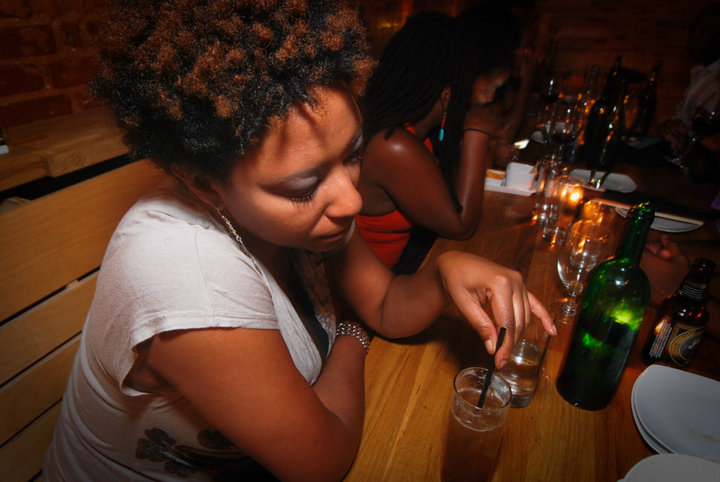 infused rum and grapefruit Ting, and my personal favorite, “The Gemini Handshake” – a mix of cachaca, lime, and locally made pineapple-habanero jelly. The bartenders are clearly master-level mixologists, and the showmanship that comes along with the drink making is well worth the price of admission.
infused rum and grapefruit Ting, and my personal favorite, “The Gemini Handshake” – a mix of cachaca, lime, and locally made pineapple-habanero jelly. The bartenders are clearly master-level mixologists, and the showmanship that comes along with the drink making is well worth the price of admission.
Oh, and let's not forget the most important element – the music. The Sound Table is a joint venture among 3 DJ-preneurs (yeah, I said it) whose aural palates are as global as the joint’s menu. Resident and guest DJs drop in often and spin an eclectic mishmash of future funk, electro soul, trip hop, dubstep and everything in between.
New York – eat your heart out.
cheers, k
Spatchcock Chicken photo courtesy of Leon Dale
Sound Table Cocktails photo courtesy of Carlos Bell
The Sound Table 483 Edgewood Avenue (at Boulevard) Atlanta, GA 30312 www.thesoundtable.com
atlanta's national black arts festival kicks off next week
Only a few more days before the 22nd National Black Arts Festival begins! Well, technically, the festival never ends since it's a year-round celebration of arts and culture across the African Diaspora. But from July 14-18, we'll be treated to a concentrated dose of all that the NBAF has to offer.
The NBAF is always a highlight of Atlanta's summer festival season with a myriad of music and theater performances, workshops, films, and educational programs that allow Atlantans and visitors from all around the globe to see, taste, hear, and feel the work of artists and artisans that have shaped and continue to influence Black culture.
Centennial Olympic Park will once again be the summer festival's home base of operations, with Main Stage performances by Afro-Brazilian percussion group, Olodum, Atlanta's own DJ Kemit, and Roy Ayers with the Common Ground Collective. Several other events - film screenings, dance and theater performances, visual arts displays, and more - will occur at locations around the city. Many of the events are absolutely free to the public, while others offer some very affordable options if you're looking for things to do on a sweltering Atlanta weekend.
Visit the NBAF's website for a complete schedule of events or download this handy Excel schedule of 2010 NBAF events that you can sort by date, event type, and price (alternate link for those without Excel).
see you at the festival,
k
mistress didi - crusader of classic fetish
**Disclaimer: some of the links and topics contained in this post are of an adult nature. If you find such information objectionable, go watch a cartoon. :)**
Bondage, BDSM, fetish, kink. When you hear those terms, images of whips, chains, leather, and latex may immediately come to mind. Less innocuous terms like freak, pervert, or deviant, are often used to describe the participants in the bondage and fetish scenes. Many people are confounded, some are intrigued (even those who won’t admit it), and others are downright repulsed by the set of behaviors classified as modern fetish. But there is at least one woman who is dedicated to preserving fetish and BDSM as an art, not only for the beauty of it, but for its therapeutic benefits as well.
Her name? Mistress Didi. Had it not been for the annual Hedonism art show at Apache I attended a few months back, our paths might never have crossed. After the show, which featured live performances and installations by several local erotic artists, I had questions. Who were these artists and performers? Did they have day jobs? What path leads one to take the stage or pick up a paintbrush as an erotic artist? I set out to find answers, and when I came across Mistress Didi, I felt that I’d found a reliable source for them. Instead of the usual graphic and provocative imagery on other fetish websites, Mistress Didi’s site provides page after page of information that is an unlikely blend of spiritual philosophy, basic manners and etiquette, and of course, fetish culture. Her emphasis on quality and artisanship in the culture has led her to coin the term classic fetish, of which she is a very vocal proponent.
After a few online exchanges, Mistress Didi - a petite little firebrand with a demeanor befitting a Mistress - agreed to let me interview her so she could explain more about the spiritual, therapeutic, and artistic aspects of classic fetish.
What do you think is the biggest misconception about fetish? That it’s not consensual and that it’s a psychological deviation. In the DSM-IV (Diagnostic and Statistical Manual of Mental Disorders, Fourth Edition) fetish is literally classified as an abnormality.
That’s sort of ironic, since you consider fetish to be therapeutic. Can you speak about how you’ve added a therapeutic aspect to fetish? What sort of challenges or blocks do you feel fetish can help people overcome? You make decisions about who you are in your life. You have to like who you are. So many times, we choose things based upon others telling us that we will be accepted or like based on their criteria. People are massively mind controlled by religion, the media… but it’s about being responsible for your actions, and living life to enjoy it. I have my philosophy of spiritual hedonism which is my religion that I invented. I figured, hey, if L. Ron Hubbard can invent one then I can too! And mine is a helluva lot more fun than his! (laughs) But my thing is about being responsible for your actions. Whatever you choose to do, be responsible for that 100%, live life to enjoy it and spread that joy. Party on!
Hey, what else is there, right? What if? That’s my motivation. What if? What if the world does end in 2012? What if something falls out of the sky on top of my head? What if this is my last inhale? When I die, I don’t want to go, “Oh hell, that sucked”. I wanna be able to say, “Alright, that was pretty cool!” I recognize that I am a sadist by nature, but I also know that as a Libra, I go to extremes. Like all my charitable work, all my healing work in my vanilla life is one end of the spectrum. And then my expertise in the sadistic arts is the other end of the spectrum. However, as I was saying to you earlier about responsibility… I’m not one of these people that has some kind of egomania going on and is picking up a whip and just flailing it ridiculously. I studied with qualified practitioners and experts in their particular genres, and I know what I’m doing. Plus I have an extensive knowledge of human physiology and human psychology and I’m always enhancing my education. I owe that not only to myself, but to the fetish community. Because if you’re gonna go out there and call yourself a dominant, then you need to be in control of your reality, your own personal space, your own domain.
That’s quite powerful. But you can take that outside of the fetish world. The thing is that we are taught to react rather than respond. Reaction is irrational and it’s designed so we can take the focus off of our responsibility. When you respond, that requires conscious choice and a decision that you make that you can live with yourself.
 So how do you respond to the mainstream’s misconceptions about fetish?
What I’ve decided to do is create better fetish. What they call fetish now are these screaming, screeching parties. At these little screeching parties with all these kids who think they’re gonna tell ME about domming… what they don’t know is that I’m old enough to be their mother, I just look better than they do. And there’s a reason for that too. Their whole concept of S&M is stand and pose. They like getting dressed up – god knows I do – but that is not the end of it all. They have no etiquette, they have no manners. Some people think fetish is kink. Fetish is not just kink. Fetish is not just about sexuality.
So how do you respond to the mainstream’s misconceptions about fetish?
What I’ve decided to do is create better fetish. What they call fetish now are these screaming, screeching parties. At these little screeching parties with all these kids who think they’re gonna tell ME about domming… what they don’t know is that I’m old enough to be their mother, I just look better than they do. And there’s a reason for that too. Their whole concept of S&M is stand and pose. They like getting dressed up – god knows I do – but that is not the end of it all. They have no etiquette, they have no manners. Some people think fetish is kink. Fetish is not just kink. Fetish is not just about sexuality.
There’s a more ancient, historical aspect to the term, right? If you look at the word fetish in the dictionary, you will see that. In indigenous cultures, these people took a physical thing that embodied the representation of how you were working spiritual energy and how you were focusing that. How u connect with the higher God energy to manifest things in your life.
Fetish (definition) - A fetish (from the French fétiche; which comes from the Portuguese feitiço; "artificial" and the Latine facere, "to make") is an object believed to have supernatural powers, or in particular, a man-made object that has power over others.
French philosopher Michel Leiris simplifies the original definition as, an ‘objectified form of our desire’.
Another misconception about fetish. People think that you go to one of these parties and someone is gonna beat you. No, no, no! If that happens, you need to complain to somebody and have the offender thrown the hell out. Because the creed is safe, sane, and consensual. I see all kinds of abominable things happening at these parties and that’s why I don’t go. I have my own parties and with the exception of the one on June 4, they’re all private. And because that behavior is fostered and allowed to breed like a cancer in our community, that’s why I wrote, “How to Properly Present Yourself to a Mistress” and offer it as a free book.
You mention on your site that your book is also useful for people who aren’t necessarily into fetish? Absolutely. I tell people to use this for their kids. Because all that it is is common courtesy and social graces. Now, if we taught our children in kindergarten 2 things. Body awareness so that they would be able to do a check-in internally, do some deep breathing or other techniques instead of fidgeting because they’re uncomfortable. And if we taught kids that it’s ok to acknowledge that I’m angry or I don’t like that. Acknowledge that and realize what else you can do with that. You don’t always have to be… well, for lack of a better word, you don’t always have to be a d*&k! You can choose to take the high road even when others are being low-lives. That’s one of the things I teach in Domina 101.
Is that what separates classic fetish – the protocols, the courtesies, and the rituals? My brand of classic fetish goes even beyond that. I call it classic fetish because we’re taking it towards the highest beauty. Have you ever seen a pair of shoes that takes your breath away and it’s a magical moment? I grew up in the fetish scene, so what it’s deteriorating today is disgusting and its deteriorating because there’s these little hoochies working in a dungeon and they think they can put the word Mistress in front of their name and that puts them in the same category as someone like me.
First of all, they’re not really dommes. They are subbing to some idiot guy with a pimp mentality. That’s why I call them ‘hoochies with whips’. The reason that we even have the distinction of classic fetish is because people have decided to abuse something that was beautiful.
How would you suggest dominants or aspiring dommes who don’t just want to be ‘hoochies with whips’ educate themselves? What about vanilla people who want to begin exploring fetish? For aspiring dommes, there are tons of seasoned dommes out there to learn from and there are organizations like TES (The Eulenspiegel Society). They should also check out my articles: The Importance of Rituals and Protocols, and Domme vs. Dumme. For newcomers to the scene, there is a website called The BDSM Resource Center. It’s a really good resource for fetish or I should say BDSM education. Fetish includes lifestyle stuff like people who just enjoy certain articles of clothing. BDSM is bondage, domination, sadomasochism – it is an actual physical expression. It’s a very physical thing.
Are there certain tools and techniques that every fetishist should have in his or her toolkit? Yes! Have a basic knowledge of First Aid. Become CPR certified, definitely own a First Aid kit. Know how to handle burns, cuts. Have safety rules. And always play with a phone nearby, in case of emergencies. I think everyone should go to a safe party - where you can actually talk to people whose lifestyles are a part of this culture. And these people are a much higher caliber versus going to a loud disco where the music is so loud you can’t hear anything. When I see people playing in these clubs where the music is so loud… that to me is very irresponsible, because you can’t see the danger signs.
As an African-American in the fetish / BDSM community, are you something of a unicorn? Do you find that there are any racial divides or misunderstandings within the fetish community? There’s a huge black culture in the whole BDSM thing. People give folks - especially those who are into being slaves or submissives a lot of flack for that. Like, given our history, how could you want to be a slave? But they don’t understand that this is a completely different concept from the slavery that we understand as a part of African-American history. That was completely non-consensual.
Talk about some of the classes you offer? Which is your most popular?
Transcendent trampling. Because when I trample it’s a sight to see. That’s my own specific technique. When I teach  that, first I start out with a basic anatomy course. Which muscles can take weight bearing, where are the places that you should never apply pressure. Where is the carotid artery... don’t lean on that! (laughs) because I was a dancer for years, when I trample, it’s a work of art.
that, first I start out with a basic anatomy course. Which muscles can take weight bearing, where are the places that you should never apply pressure. Where is the carotid artery... don’t lean on that! (laughs) because I was a dancer for years, when I trample, it’s a work of art.
I seem to get a lot of response for Max Wax, my waxplay course. Now the vanilla women are really funny. They want to know all of this stuff, but if it’s not presented to them in a way that they feel they won’t be judged, then they can’t get with the program. So I have a course that I call Role Play 101 – and it’s really just a basic introduction on how to spice up your sex life with your honey.
Where would you like to see fetish go? Ten years from now, do you think you’ll still be involved in fetish? Oh, absolutely. This is a part of who I am. I think folks think it’s something you do on the weekends. This is part of who I am, not just how I am. Most people don’t realize that who they are can be quite lovely… how they are is quite wretched.
To be a dominant means you choose how things are for your comfort and your ultimate well-being in your life. People don’t like that. They think it means you put on 8-inch heels and walk around with your butt hanging out, but I only do that on special occasions and only for special people. And no I DO NOT have sex with my playmates. This is not a sexual thing for me. This is a connection between two people on a level that is spiritual, physical, emotional, mental and is totally transcendent. And because I have that experience on a regular basis, I see how many people are not having it, and that’s what's missing from what is considered fetish in the mainstream today.
It’s not necessarily for everyone else. But I say, don’t knock it until you try it. There are things that you’ll discover that you don’t like, and you just have to understand that that’s what YOU don’t like. Just try not to judge what other people do like. And there’s some nasty stuff out there – very unhealthy stuff. I don’t understand how folks get into it. But I try not to judge it, I just make my choices not to indulge with them.
At this point in our talk, Mistress Didi’s dog, who she calls Li’l Doggie enters and asks for a treat. She shares that Li’l Doggie – who she got from an animal rescue - doesn’t have much longer to live. She moves on to tell me about another dog that she rescued previously that had been abused.
I took him, in a short amount of time, from being in a place of extreme fear to being able to sit on strangers’ laps. And that, to me, is dominance. Because I created an environment for him to become as beautiful as he could be, and to love life as much as he could. And that is what BDSM is for me. That’s what I believe the goal of being a dominant is. You don’t just have someone in your life because you can. It should be a mutual evolutionary process.
We move on to talk about other things like: her future plans to open a private fetish club in NYC (contact her if you're interested in investing), RuPaul's Drag Race (she's a fan), and the fact that she feels this season's RPDR winner - Tyra Sanchez - is a good role model for his son.
I'd love to meet her. Tyra accepts who Tyra is. Tyra says to the world, this is how I express myself and how I love living.
How dare someone tell me how we should love. Look what their way of loving got the world.
For more information about Mistress Didi and her brand of classic fetish, check out her website, her blog, or follow her on Twitter.
cheers,
k
20 things mama used to (and still does) say
I was listening to WABE the other day and the announcer asked for listeners to call in and share things that their mother always said that they still remembered. I didn't get a chance to call in and share my memories, but in honor of Mother's Day, I thought I'd share them with you, Dear Reader. Here goes...
1. It’s better to have and not need than to need and not have.
2. There is a difference between being a woman and being a lady.
3. Always be observant.
4. Your beauty may open a door, but your brain will keep it open for you.
5. The streets will always be there.
6. If you ever feel you want to try drugs or alcohol, come to me first. (yeah, my mom’s progressive as hell!)
7. Bedtime is at 9:30 pm. (progressive, yet ridiculously strict!)
8. Always take 2 quarters with you, so you can use the pay phone if he acts up on the date. (obviously before cell phones!)
9. Never go for the HMO option.
10. Real ladies keep their shoes on all night (for those of y’all who like to wear those heels you can’t walk in).
11. As long as you live under my roof, you will do what I say.
12. Never say, "I don’t know" when I ask why you did something. Say, "Because I wanted to". You should always know why you did something.
13. Y’all called me up to the school for THIS? (when I got in trouble for saying the word ‘penis’ on camera in high school)
14. Don’t be the one who is influenced. Be the one who influences.
15. People didn’t expect much from you because I was a single parent. Just shows you that you shouldn't worry about what people expect.
16. I got you this far. I’m done raising you. The rest is up to you.
17. I guess I have to cut the apron strings at some point.
18. Alright, queen. don’t forget I am yo’ mama! (said when we ‘argue’)
19. Aren’t you lucky to have such a beautiful muuuther!? (I am, by the way)
20. You know I always got your back. (and I got yours, mama!)
What are some things your mother used to (or still does) say?
Happy Mother's Day to all the moms out there. We hear you, even when we're not listening ;-).
cheers,
k
Career Transition: 8 Steps For Turning Your Craft Into A Career
Your day job is what pays the bills. So you get up every day and go to work faithfully. But secretly (or maybe not-so-secretly), you harbor a passion for some other work – your craft – that one thing you feel like you were destined to do with your life. The only problem is, if you were to jump head first into pursuing your passion, you might not be able to keep the lights on. So, maybe you should just give up on that dream of yours, right?
Wrong. If you’re focused and willing to put forth a little extra effort, there’s a way for you to make it happen. While there’s no guaranteed path to success, here are 8 steps that will undoubtedly help you transform your part-time hobby into a full-time career.
Educate Yourself - Either enroll in a paid course or do some targeted self-study. Buy books and read articles in industry publications. You need to get very smart about the history, and current and future trends of the work you want to do. Is there a viable market for what you want to do? Also, get a feel for what goes on behind-the-scenes of the craft - those things that you'll have to do that aren't necessarily related to the craft itself. For instance, if you want to be a writer, you need to learn how to write pitch letters. If you want to be a musician, you might need to learn about putting together a press kit or music copyright law. Find out what average salaries or pay rates are in the field. This step alone may make you second guess your decision to pursue your craft as a full-time career.
Carve Out a Niche - How do you do your work differently? Are your products and services for a certain type of person or audience? What can you do with your work that's totally unique? Develop your own persona, your own set of offerings that's just a little bit different than what's already out there.
Build a Resume - Whether you want to work your craft as an employee or as a business owner, you'll need to show that you're experienced. Early on you may not have a lot to put on a resume, so seek out volunteer or non-paying opportunities that will give you that experience. Look at previous jobs that may have required you to use the same skills, even though you might not have had the exact title. If you have the time and energy, consider moonlighting or taking some one-off projects or a part-time gig in the field you’re looking to break into.
Join a Flock – Seek out a trade association, industry organization, or just a network of people who are doing the same work. Be active, ask a lot of questions, let people know that you're trying to break in to the industry, ask for ways you can lend your talents to the group, offer to take people out to coffee, to collaborate with them on their next project. Above all, be genuine with this group. They'll be like your new family.
Tell Everyone - Tell everyone you know - friends, family, former co-workers, the guy who makes your coffee at the corner café – about your ‘new’ line of work. This is for two reasons: 1) so you get comfortable claiming your new career, and 2) so people you know start seeing you as this person. Ideally, you should get some self-promotion tools in place - business cards, a website or blog - so you can showcase your talent to the world.
Define Your Prey - Clearly define who your target customer is or what type of organization you want to work for. How far are you willing to travel? How many hours do you want to work? What types of people do you want to work with? What kind of salary are you willing to accept? Get clear about what it is you're actually looking for, and then...
Go Hunting - Talk to contacts in your network that can introduce you to your target clients. Hang out in places where your clients hang out (be sure to bring your self-promotion items with you), meet people and follow up with them, even if it's just for personal reasons. This step is about building the relationships that will get you closer to your ideal client or type of work.
Be Patient Persistent - If you're lucky, you may achieve success overnight. If you're patient, you'll wait as long as it takes for success to come to you. But if you're persistent, you'll realize that it takes both time and consistent effort for you to reach a desired level of success, and you'll continue to do the work required to meet your goals.
Have any other tips for how to make your part-time passion your full-time career? Drop 'em in the comments.
photo credit: Tony the Misfit
cheers,
k
QUICK POLL: what do you want most for valentine's day?
I'm doing some research for a future post, Dear Reader, and I could really use your input.
Valentine's Day is fast approaching, and from my experience, it's a holiday that seems to cause more angst than any other. There's the increased pressure of what to get your beloved, and the heightened expectation of what you'll receive. Then there are those who relish the once-a-year opportunity to vocally denounce love, the commercialization of love, and the love of commercialization. And finally there's that lonely lot - that each year we all secretly hope we're not a member of - of unattached, uninvolved folk who feel compelled to treat V-day as a national day of mourning.
So I thought it'd be interesting to get a pulse on what kind of things people actually want for V-day. I've created two polls - one for the ladies, and one for the gents. When you get a moment, give me your thoughts. I'll share the answers with you before V-day.
Here's the poll for ladies:
alternate link: http://poll.pollcode.com/A8N
And here's one for the guys...
| GUYS: What Kind of V-Day Gift Would You Prefer This Year? | |
| A store-bought gift (e.g., cologne, clothing) | |
| An experience gift (e.g., travel, spa) | |
| A sexual gift | |
| I want to be left alone | |
| What gift? V-day is for suckas! | |
| pollcode.com free polls | |
alternate link: http://poll.pollcode.com/CrYq
cheers,
k
Behind the Scenes at the NBAF: Rebekah Jones - Production Manager
It’s a little past 8 am on Thursday morning, the second official day of the 2009 National Black Arts Festival. Several of the festival’s staff members are seated at multiple round tables on a lesser-used part of the 5th floor headquarters office. On the other side of the floor-to-ceiling windows, the sun is defiantly beaming through the last of the overnight storm clouds.
The woman with cropped, spiky hair sitting at the head of the group speaks.
“Just so y’all know, we do have a weather fairy, so it’s not going to rain on the festival.”
The woman is Rebekah Jones, who wears the double title of Festival Manager and Production Manager for the NBAF. She acts as Mistress of Ceremonies for this morning’s staff meeting, quickly running down what’s going on at each of the day’s major events and venues, and double-checking to make sure everyone has their marching orders. Since a major part of the festival – the International Marketplace – will be held outside, the topic of the weather comes up again soon, this time with a bit more gravitas.
“The only reason we will shut down is if there’s lightning. Our setups are all graded for up to 40mph winds. If there is lightning, the head of security will make the call to me or Leatrice (NBAF Artistic Programming Director), and we’ll make the decision to pause the festival, and issue ‘seek shelter’ announcements to the crowd.” Before the team disperses, she makes sure everyone has a copy of the Crisis Response Plan for the festival.
When the meeting ends, Rebekah heads back to her office and settles in behind her desk. Within 30 seconds, the small office is filled with 3-4 staff members with last-minute tactical questions for her. After handling the first few questions, she shoots me a look and says, “Time for a cigarette break,” my cue that we’ll have to conduct our one-on-one interview downstairs.
Once there, we begin.
ksolo: So how long have you been with the Black Arts Festival?
RJ: Since 2000. I think. Whatever year Stephanie (Hughley)joined. We’d worked together at another festival, so when she came over here, I thought it would be good to work with her again.
ksolo: For the layperson, what exactly does the co-title Festival Manager / Production Manager mean? What are you responsible for?
RJ: Well, I’m a Project Manager. I work as a PM for several clients, Harley Davidson is one. I’ve been the Production Manager for the Atlanta Civic Center for the past 12 years.
ksolo: Wow, do you sleep?
RJ: (laughs) Sometimes, I can’t believe I get paid to do what I do. I’m about to turn 50, so I figured, ‘Forget it. I’m just gonna do what I love.’
ksolo: With the changes in this year’s festival – the reduced timeline, the central location – has it been an easier project to manage? Or are there some things that are more difficult?
RJ: Well, the coordination has definitely been less cumbersome. There are fewer moving parts. But this year, we’re shutting down a city street for four whole days. And you have to jump through a lot of hoops for that.
In a moment of candor, Rebekah uses a four-letter word to describe the frustration of the hoop-jumping, and asks me to excuse her French. I assure her that I too speak French on occasion.
ksolo: About how many staff and volunteers do you have for this year’s festival?
RJ: With contractors and all, we’ve got over 100 people. And Keith (Hill) has volunteers on a waiting list. We have a great synergy of people, a great team.
ksolo: Do you have a favorite festival memory?
RJ: (pauses to think for a bit) Opening day. Every year. You know, this is the oldest surviving black festival in the country? Which is great, but also sad… since it’s only the 21st year. But it’s huge. It’s such an important event. Last year, we did 273 shows in 10 days. So the number of impressions is just huge. We’re in over 20 spaces this year, between festival events and events that partner with the festival.
ksolo: That’s a pretty impressive reach, especially for a city as spread out as ours.
RJ: Yep. The Dogwood Festival and the National Black Arts Festival are the only 2 festivals remaining in Atlanta that originated in Atlanta. The Atlanta Arts Festival is gone, Montreux is on hold. But we’re not just a local festival. We’re national. People plan their family reunions to coincide with the festival.
ksolo: Wow – that’s a real testament to the impact the festival has.
RJ: Yeah, we couldn’t do it without the people we have working and volunteering. We run up against a problem, and we don’t think, ‘Oh, it can’t happen.’ We think, ‘What has to happen to make it happen?’ You have to remain very fluid.
When the river starts flowing, you can either build a dam, or… you can jump in and swim.
The NBAF Summer Festival goes from July 29 - August 2, 2009. The 5-day long festival highlights the artistic and cultural contributions of Africans and African-Americans in the US. For a complete schedule of events, visit www.nbaf.org/events. To donate to the festival, visit www.nbaf.org/support.
how to do the mayan riviera - playa del carmen
When it comes to defining the perfect vacation, I admit I'm a bit schizophrenic on the issue.
Part of me wants to flex my Indiana Jones muscles and swing from jungle vines, jump off cliffs and trek through virgin forests. Part of me wants to submerge myself in all the indulgences that I usually only dip my toe in, and still another part wants to make like a bump on a log and do nothing more than watch the world go by before my half-lidded eyes.
Strangely enough, none of me has ever expressed the desire to head for a place that's been designated ground zero for a possible pandemic, but that didn't stop me or the beau from boarding our flight to Mexico for my birthday trip. You see, we well-raised Southerners don't just abandon our neighbors when they're sick. No siree. What we do is pack up a bowl of homemade chicken soup and bring it right to them. So we boarded our flight with a heaping serving of optimism tucked into our carry-ons to share with our neighbor to the South.
Playa del Carmen
Our first stop on the 6-day trip was Playa del Carmen. About 40 minutes south of the airport in Cancun, Playa is sort of like the Virginia Highlands to Cancun's Buckhead. Where Cancun is known for its non-stop frat-boy party atmosphere, Playa del Carmen attracts a more laid-back, bohemian crowd. At the south end of Playa del Carmen is a gated beachfront community known as Playacar, which includes several vacation rentals and all-inclusive resort properties. We were booked to stay 2 nights at the all-inclusive Riu Tequila in Playacar, but after pulling up to the first Riu property - Riu Yucatan - and asking the security guard, "Donde esta Riu Tequila?" I got, "Esta cerrado". Er? Cerrado? I gave the guard my 'whatchu talkin' 'bout Luis?' look, and he directed me to the front desk for a full explanation in English.
As it turned out, of the 5 Riu properties located in Playacar, only the Riu Yucatan was not 'cerrado' and everyone who had reservations at the other resorts had been consolidated into one. Even then, the property was probably only at about 60% capacity. Apparently, not everyone shared our optimism about the flu scare. Fortunately though, the change was a bit of an upgrade, since the Riu Yucatan was located directly on the beach.
After settling into our room, indulgent me began to get restless at the thought that an endless supply of free liquor was only steps away, so we made a beeline to the poolside bar. Before the end of our second drinks (note: at an all-inclusive, time is measured in number of drinks consumed), we met and made fast friends with Jen and Rico, a couple visiting from Dallas. Jen and I hit it off when we quickly learned that we were both Geminis, and shared similar tastes in music.
The next day and a half at the Riu was a pleasantly muddled blur of dips in the ocean, visiting the bar, sunning on the beach, visiting the bar, eating, visiting the bar, napping, and visiting the bar. For some reason, I even forgot my camera in the room a couple of times. Must have been the sun. I was still able to get in a few shots around the resort though...
... I also learned that the proper way to kill 'la cucaracha' is to light it on fire and slurp it down with a straw.
But most importantly, I learned that sometimes you just gotta know when to say 'when'.
The guy in the photos above is actually a trained professional. He's from Belgium. I hear they start drinking in kindergarten there.
On our last day in Playa, we decided to give the Riu's so-so buffet a break. We headed out with Jen and Rico to La Floresta, a restaurant recommended by one of the Riu resort staff who lived in Playa. La 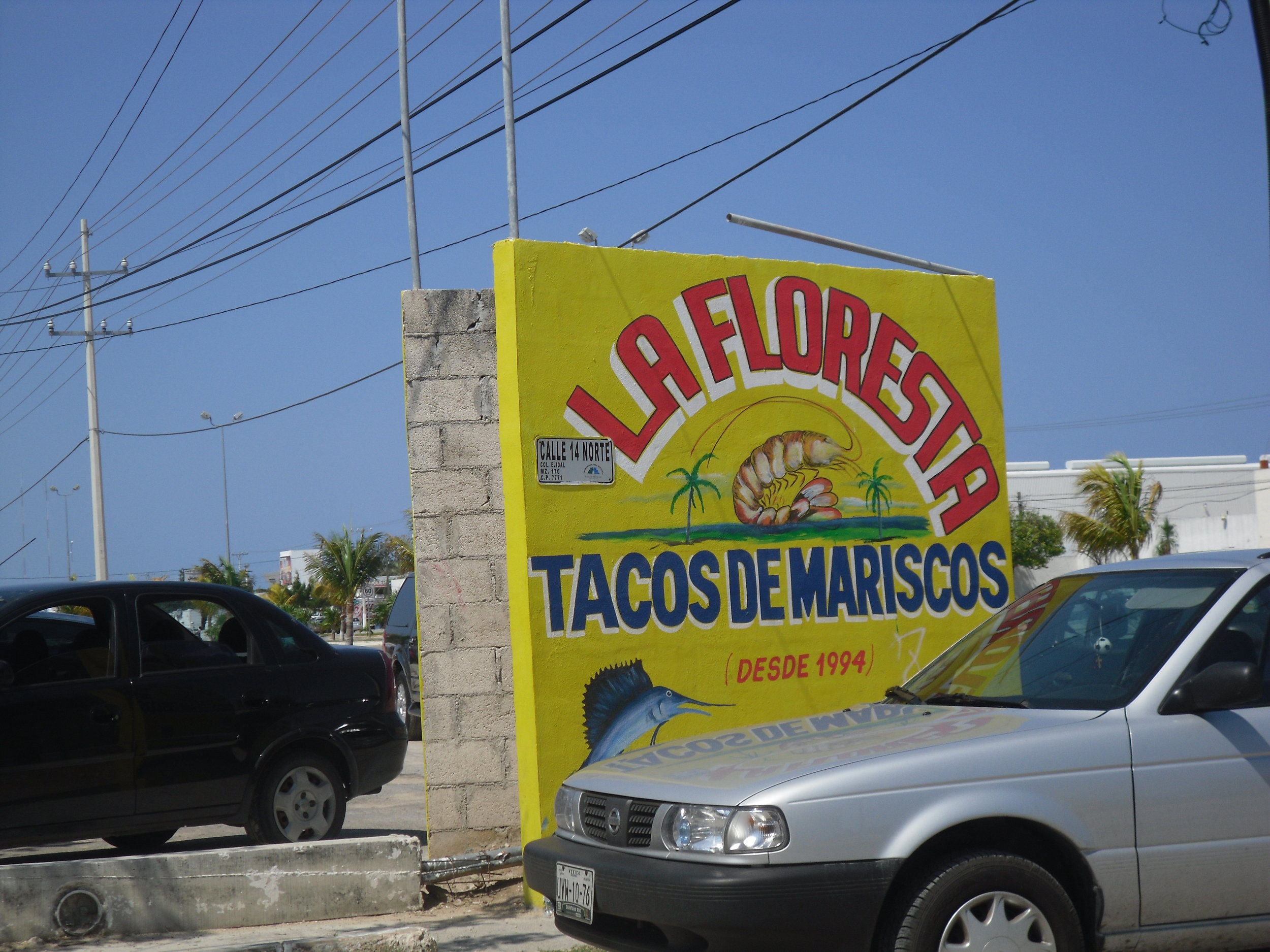 Floresta is well-known in the area for its seafood tacos. In fact, there's not much more on the menu. There's a choice of crab, shrimp, fish, or marlin taco, plus ceviche and 'cocteles' and beer. Rico is Mexican-American, and speaks fluent Spanish, so he quickly informed our waiter that we would be having one of everything. In less than 5 minutes, a slew of the tastiest, freshest seafood tacos began arriving at our table, followed by unbelievably large servings of mixed seafood ceviche and a large mixed seafood coctel - which included shrimp, octopus, scallops, and oysters in a sweet-tangy tomato based sauce. I'm actually getting kind of sad writing this, as it seems so very, very unfair that I have never experienced anything quite like that meal before, and will probably have to go back to Mexico to experience it again. Everything was very simply prepared so the freshness of every ingredient from the soft corn tortilla to the seafood that tasted like it had just swum onto the plate, was highlighted. I added nothing to the tacos other than a few drops of the 'sweet-jesus-that's-hot' green habanero sauce on the table. When la cuenta arrived, I was surprised to see that our whole meal came to $50 USD. Yep - 2 orders of ceviche, 1 large coctel, 8 tacos, chips and salsa, and beer... for about $12 per person. Sigh.
Floresta is well-known in the area for its seafood tacos. In fact, there's not much more on the menu. There's a choice of crab, shrimp, fish, or marlin taco, plus ceviche and 'cocteles' and beer. Rico is Mexican-American, and speaks fluent Spanish, so he quickly informed our waiter that we would be having one of everything. In less than 5 minutes, a slew of the tastiest, freshest seafood tacos began arriving at our table, followed by unbelievably large servings of mixed seafood ceviche and a large mixed seafood coctel - which included shrimp, octopus, scallops, and oysters in a sweet-tangy tomato based sauce. I'm actually getting kind of sad writing this, as it seems so very, very unfair that I have never experienced anything quite like that meal before, and will probably have to go back to Mexico to experience it again. Everything was very simply prepared so the freshness of every ingredient from the soft corn tortilla to the seafood that tasted like it had just swum onto the plate, was highlighted. I added nothing to the tacos other than a few drops of the 'sweet-jesus-that's-hot' green habanero sauce on the table. When la cuenta arrived, I was surprised to see that our whole meal came to $50 USD. Yep - 2 orders of ceviche, 1 large coctel, 8 tacos, chips and salsa, and beer... for about $12 per person. Sigh.
After lunch, we did a little shopping in the pedestrian-only area of Playa del Carmen, before bidding Jen and Rico goodbye and heading south to our second destination, Coba.



After the all-inclusive bingefest, I was glad to be heading for a more rural setting.
how to do atlanta - where to find the best fries in atlanta
I know I shouldn't love them as much as I do, but...I do. I mean some people like french fries, but I truly love them. You know, kinda like an addict truly loves crack. Ask any friend of mine who's made the unwise decision to reach for a couple of fries from my plate. Let's just say, no one has ever done it more than once.
This weekend, I happened across Meredith Ford's latest list of the 5 best fries in Atlanta. Of course, being the fry fiend that I am, I made a mental note to check out a couple of the places on her list whose fried taters I haven't yet sampled (Shaun's and Porter Beer Bar), but there were others that I was surprised made the cut (Steak and Shake? really?). After reading, it inspired me to pen my own list of Atlanta restaurants with the best fries.
Check 'em out and let me know if there's some other places you know of in the city where I should be fueling my addiction.
5. Five Guys Burgers and Fries
Something about the whole Five Guys fry experience is just, well...dirty. But that's part of what makes them so good. Oh you're just gonna throw the fries into a little styrofoam cup? How delightfully low-brow! Grease stains on the bag? But someone might see...oh hell, I don't care. Give 'em to me, give them all to me! Let them spill over the cup into the bag. Let the cajun seasoning stick to my fingers so I have to lick it off. And when I'm done devouring them like I have absolutely no home training, hand me a napkin so I can ever so daintily dab the evidence off my lips. Nothing to see here, folks. Keep it movin'.
Here's where Meredith and I definitely agree. This authentic tapas restaurant serves up fried potatoes with a Spanish flair. Eclipse di Luna's patatas bravas are chunky cut, covered in a saffron-hued seasoning mix, and served with a side of romesco sauce, which is sort of like a spicy aioli. Ay, que sabrosos!
Honestly, the fries at Corner Tavern are only slightly above average. But what pushes them to such a high place on my list are the dipping sauces, of which there are six to choose from. An order of the never-frozen, skin-on spuds comes with your choice of not one, not two, not three... but FOUR dipping sauces! My faves are: curried ketchup, BBQ, and Thai chili (I usually double up on this one).
2. Cafe di Sol
The shoestring potato often gets the shun from me. Mainly because most places just don't do them right. They're either so thin that they fry up hard and insubstantial; or they're underseasoned and just taste like... shoestrings. Cafe di Sol, however, avoids both of those missteps. Their hand-cut shoestrings are just thin enough to get a good crispy exterior, but thick enough so you still enjoy the mouth feel of the fluffy interior. They're also liberally seasoned with a mixture of what I think is garlic, salt, and pepper, and sprinkled with fresh chives. I effs with these crabcakes.
The reason for The Shed at Glenwood claiming the #1 spot in my list can be summed up in three words. Black. Truffle. Powder. A light sprinkling of this earth-colored pixie dust takes an already spectacular fry to drool-worthy proportions. The Shed's taters are made like the traditional Belgian fry (should it really come as any surprise that the folks who give us such great beer would also have such good fries?). Cut into batons and fried twice - once on low heat and once at extremely high heat - the result is a crispy fry with a luxuriously creamy interior. But thankfully, even perfection isn't good enough for The Shed. Chef Lance Gummere makes them absolutely decadent by adding black truffle powder - which retails for around $15 an ounce. But it's worth every penny. The powder imparts a rich, umami flavor that's almost like eating meat. OPULENCE! Thank you Chef Lance! And shouts out to the Belgians. Oh, and uh...good looking out, pigs.
cheers,
k
how to do panama - sunday in el valle de anton
how to travel to panama. a lazy sunday at la rana dorada and the sunday market in el valle de anton.
Greetings! I'm sitting on the terrace now with a view of the mist caressing the side of the mountains, drinking my morning coffee and awaiting a breakfast of fresh fruit juice (which most likely came from the fruit growing on property), sausage and pastries. I woke around dawn to get a glimpse of the sunrise, and take some pics. Ran into Becky having her morning walk with the dogs, and she showed me around the place a bit. We stalked an iguana that lives on the property, but didn't catch a glimpse of him, unfortunately. I WAS able to catch some hummingbirds though! And a little later, Monty, the three-toed sloth who hangs out on the property, peeked his head out to say, 'buenos dias'.
*********
Before leaving El Valle, we did some shopping at the Sunday Market and hit the hot springs. Sunday Market is a weekly event in El Valle, where tons of arts and crafts are for sale as well as fresh fruit and veggies. At the hot springs, we had a chance to soak in the naturally warm pools and give ourselves mud facials. Our visit was cut a little short by the afternoon rain, so we packed up and bid a fond farewell to El Valle.
This afternoon we're off to Gamboa - a rainforest area. Keep ur fingers crossed that we don't have any more traffic mishaps.













